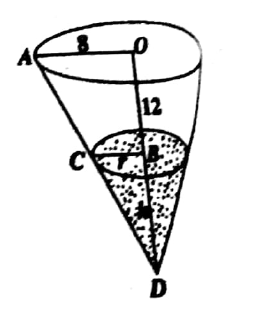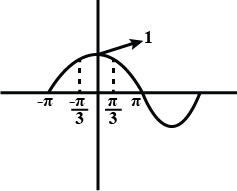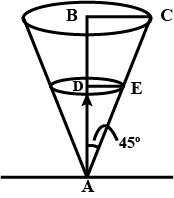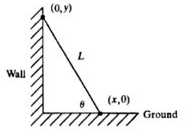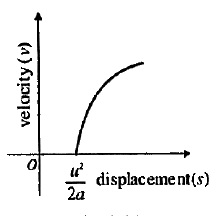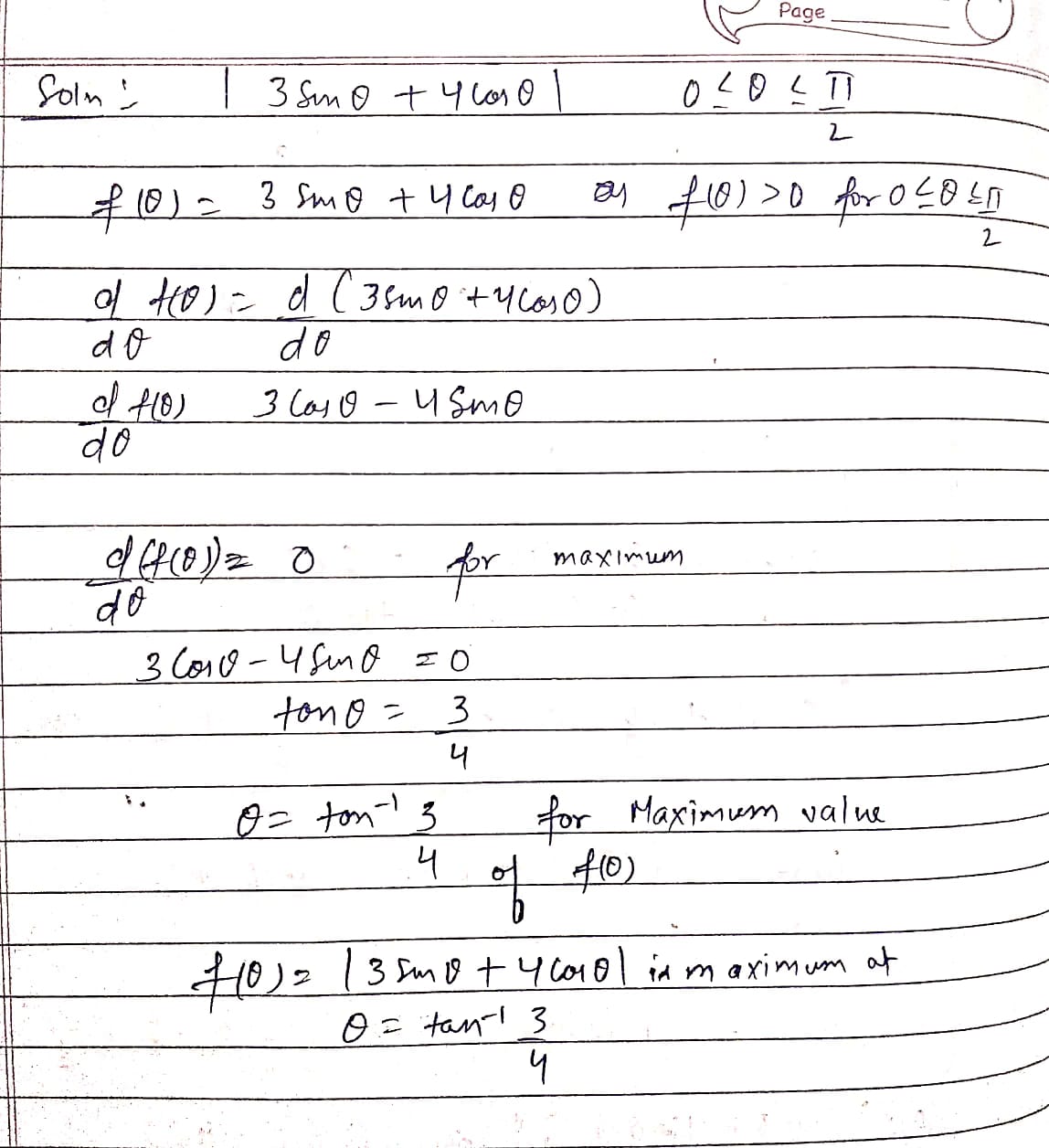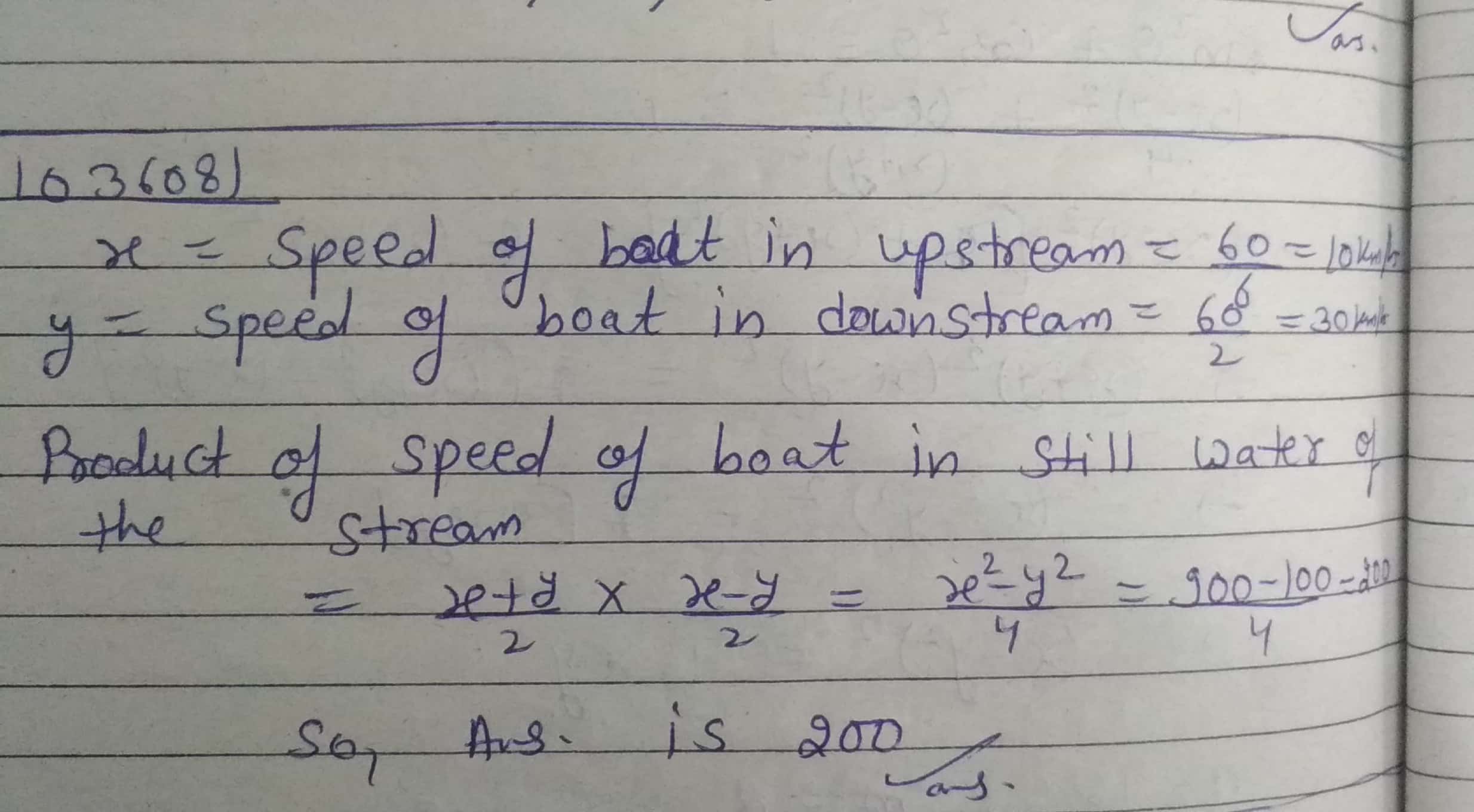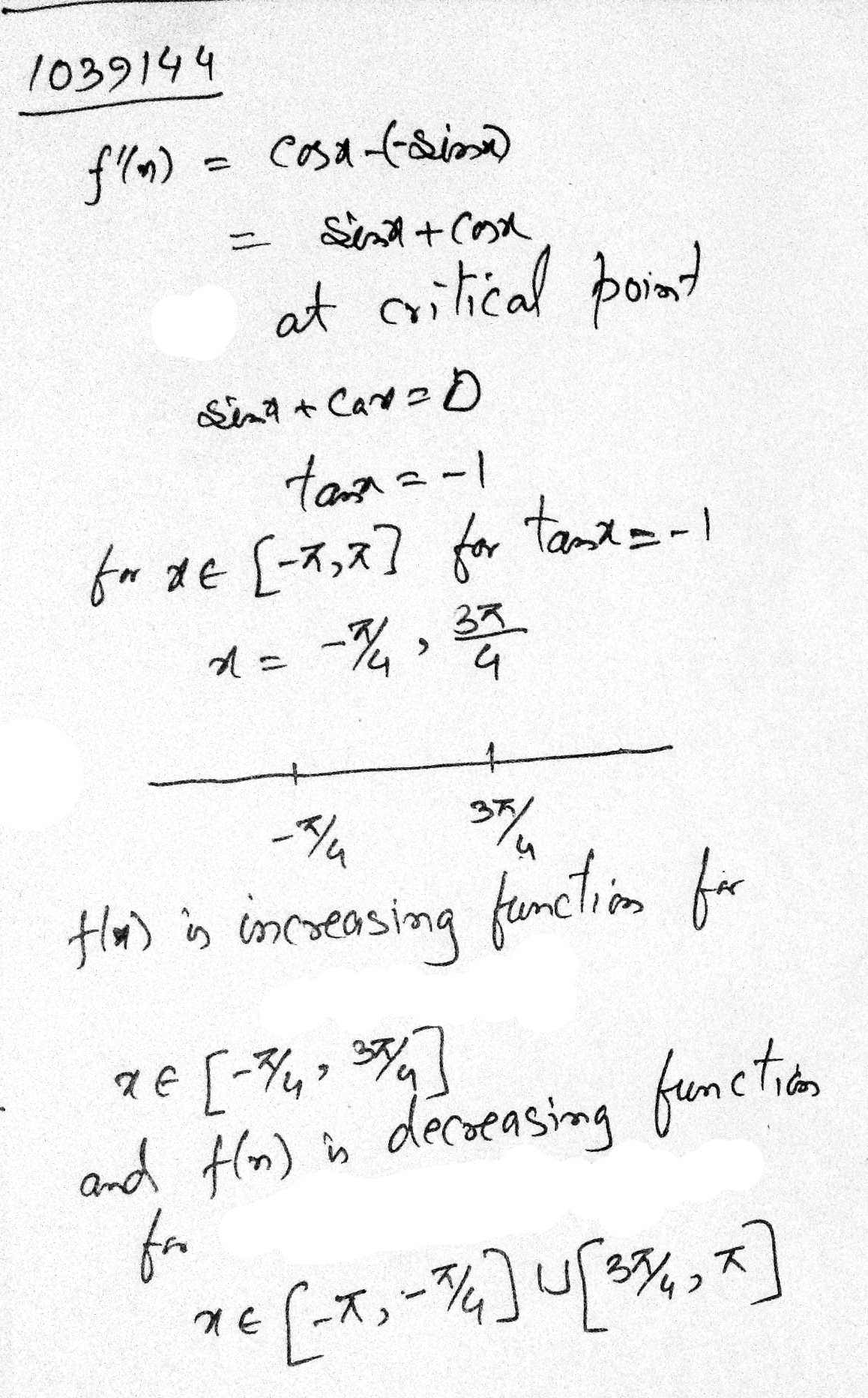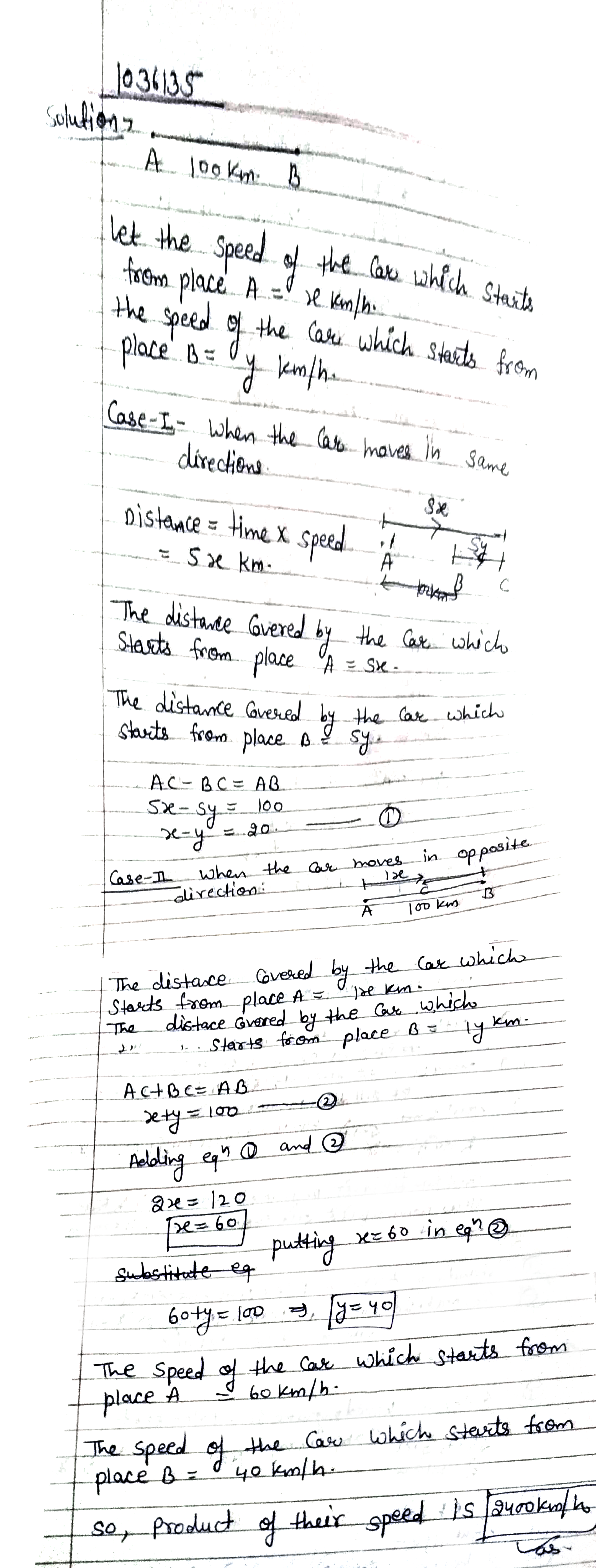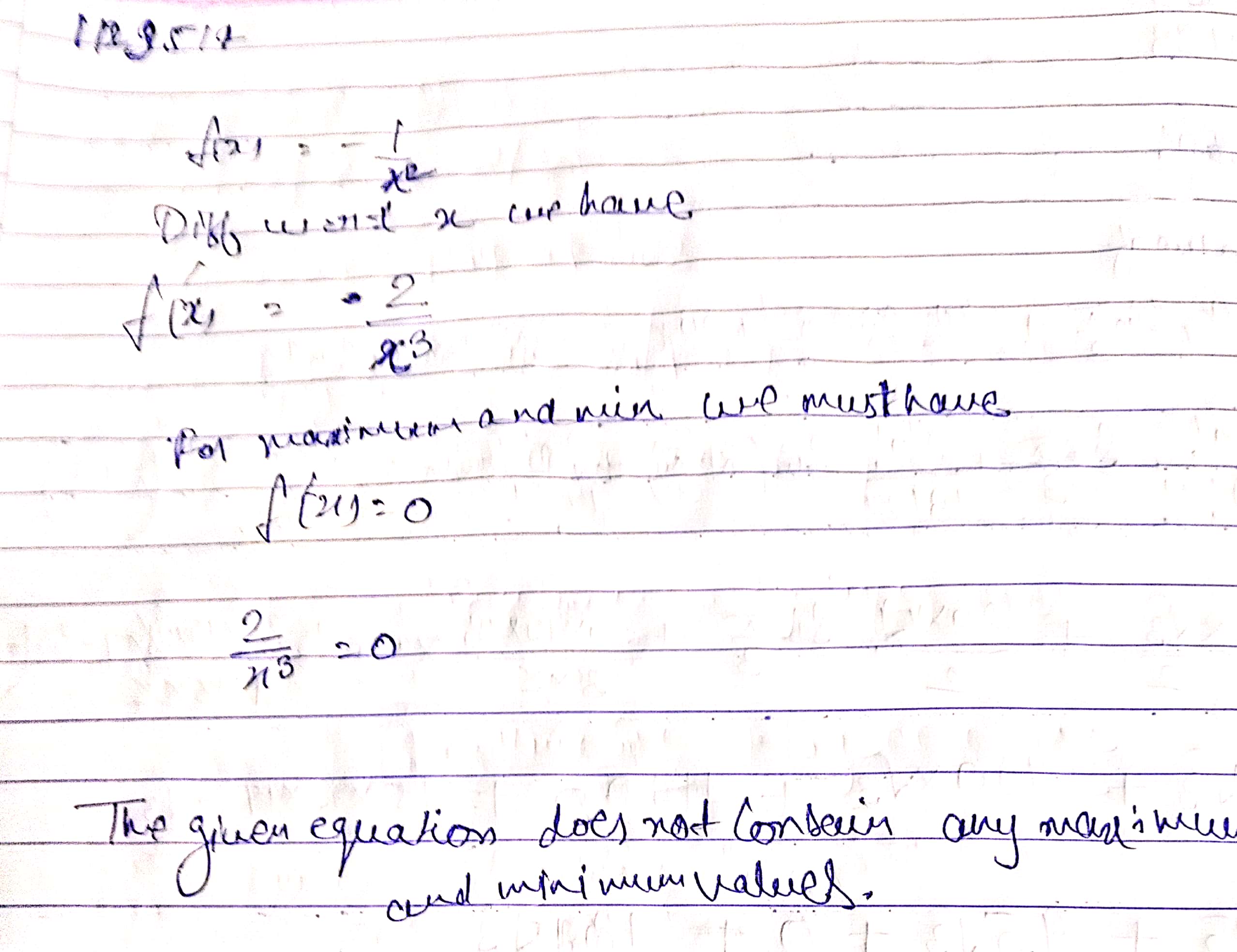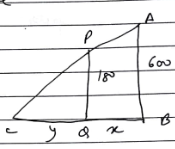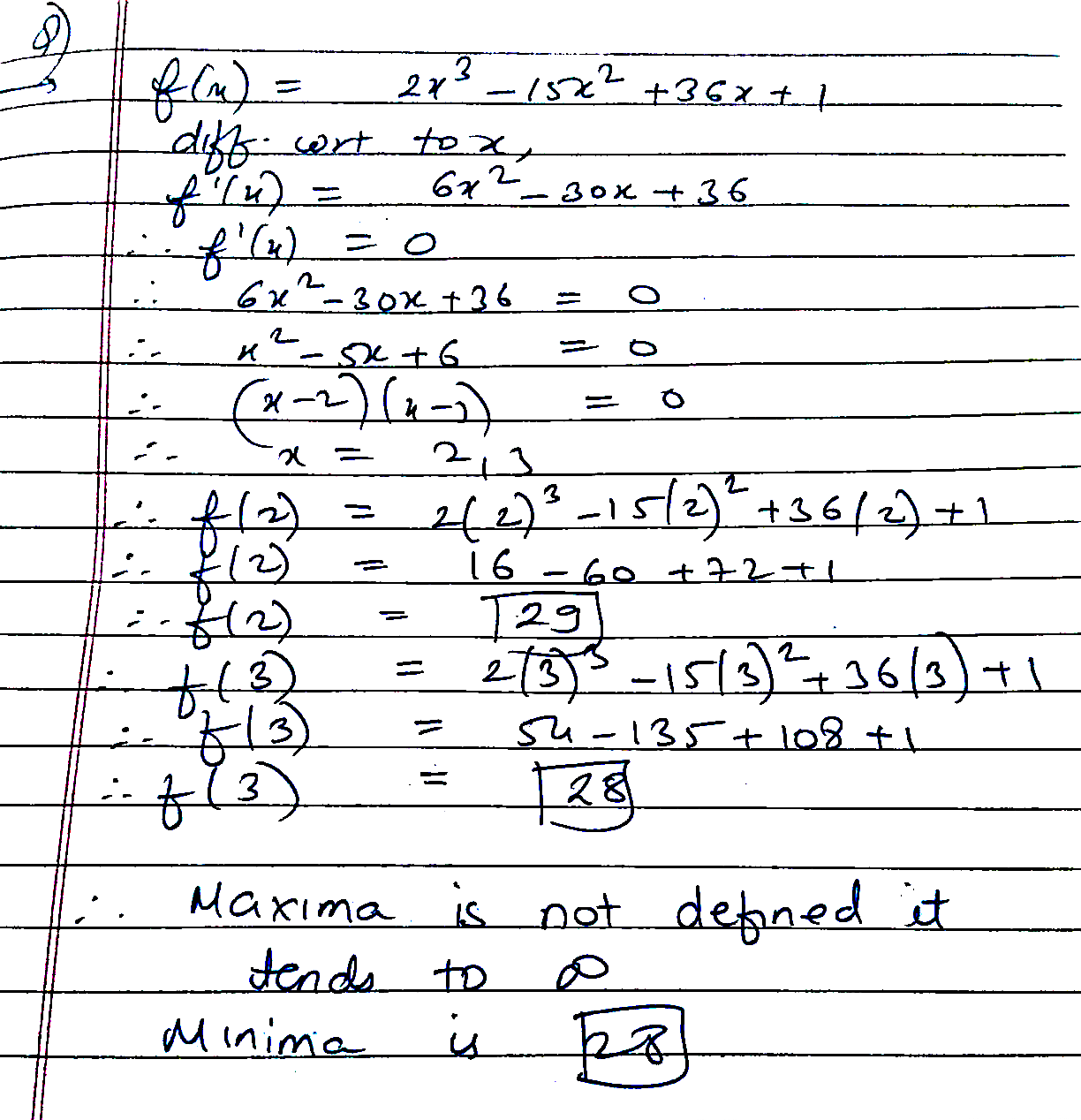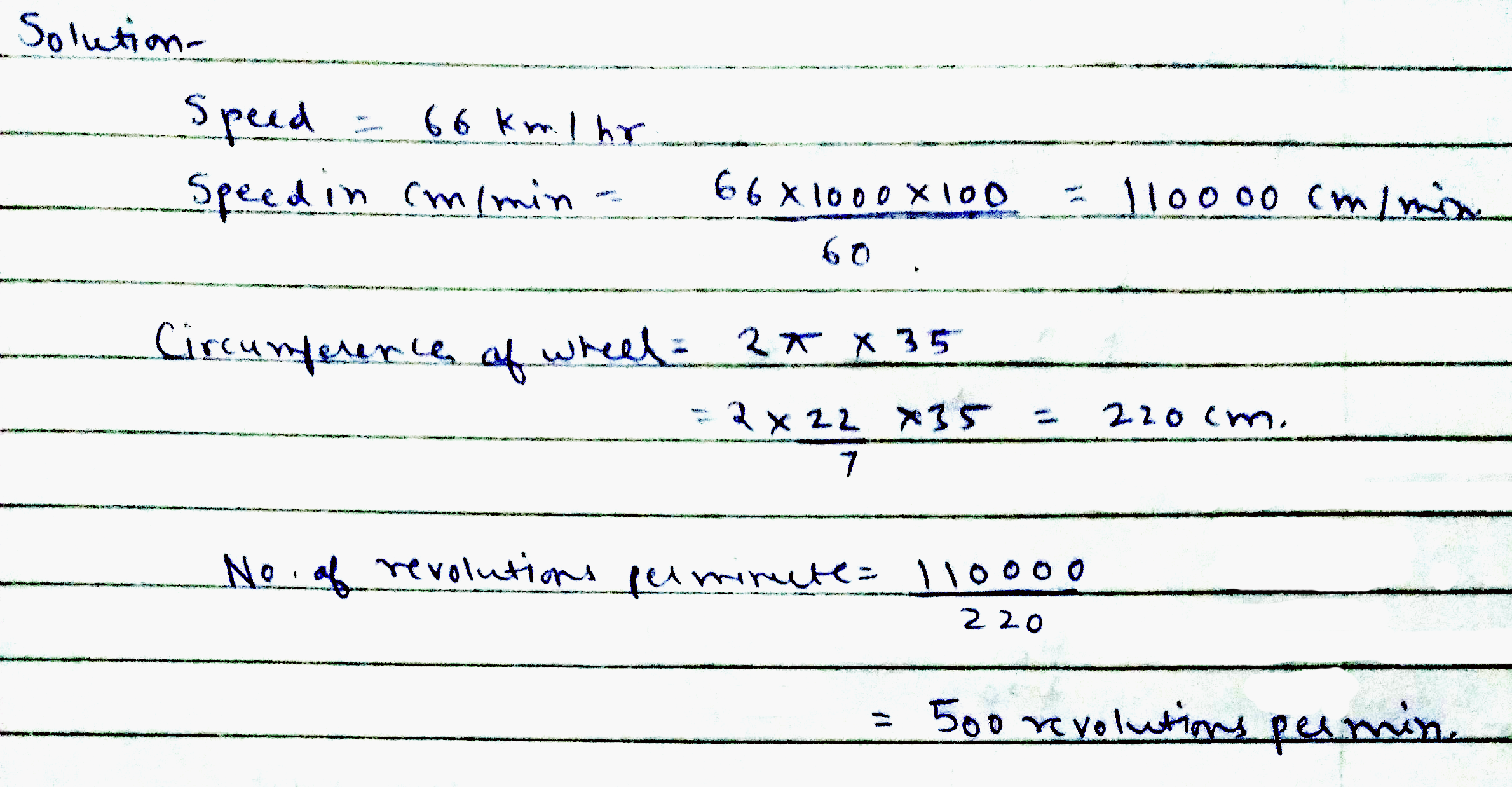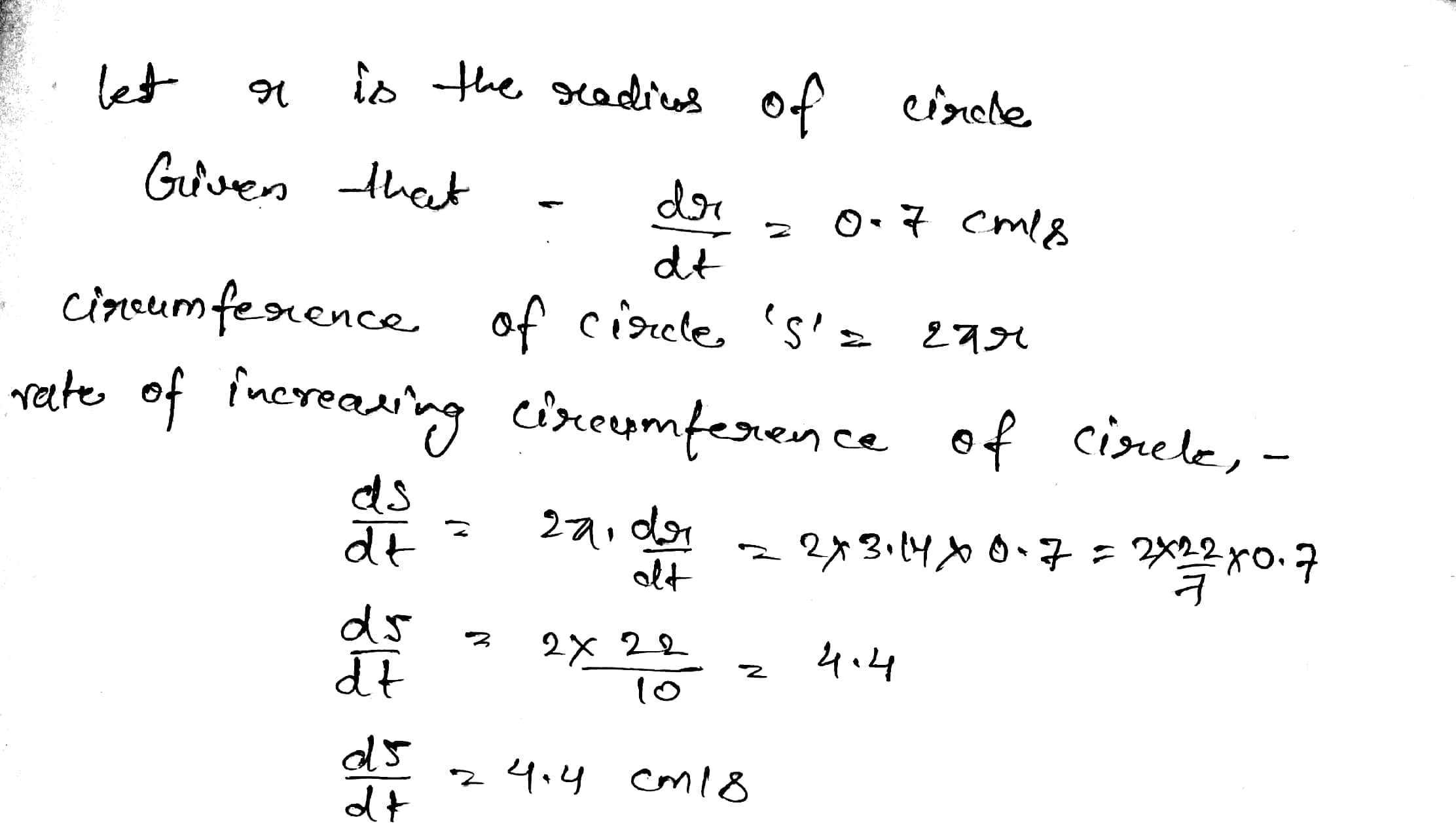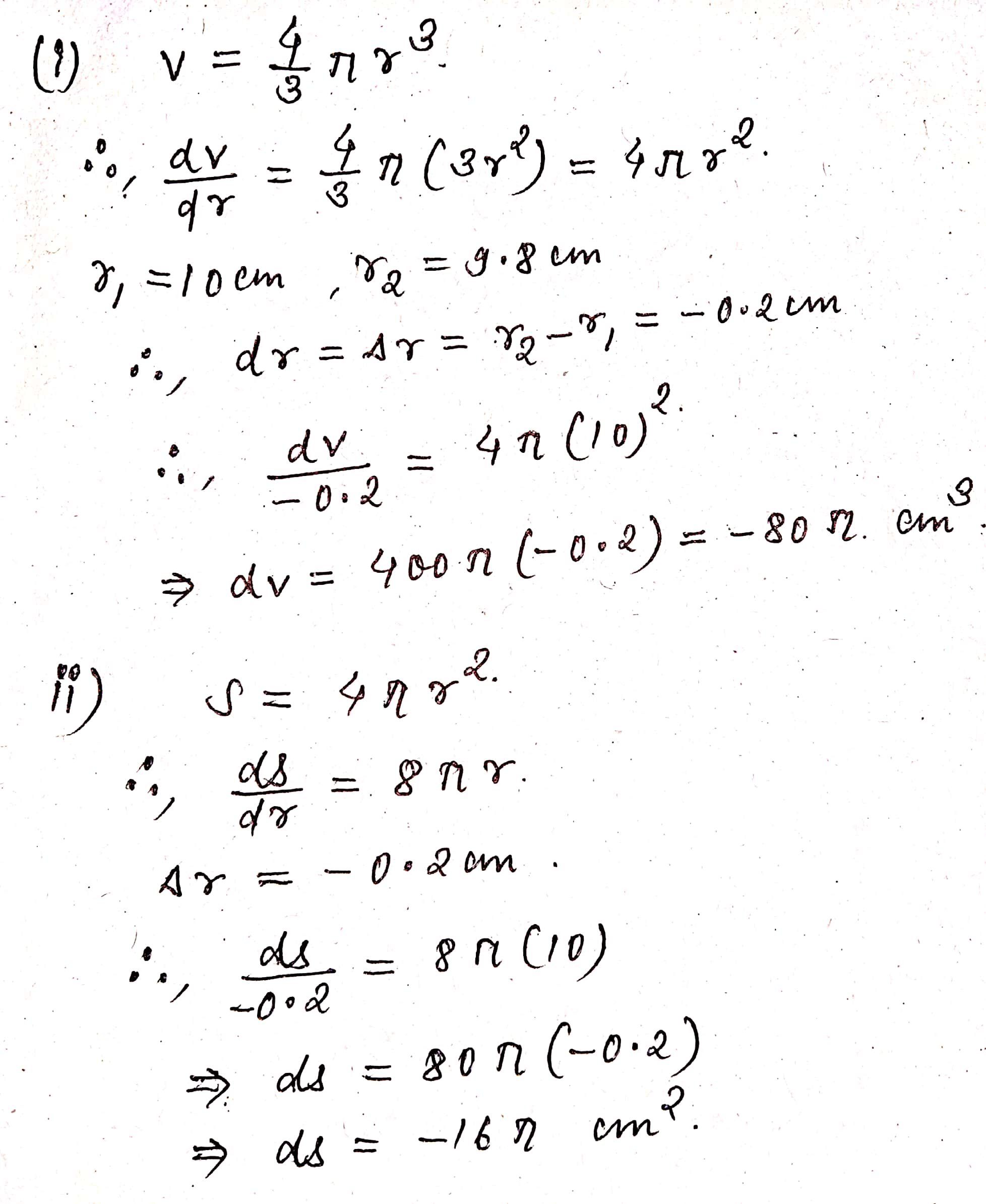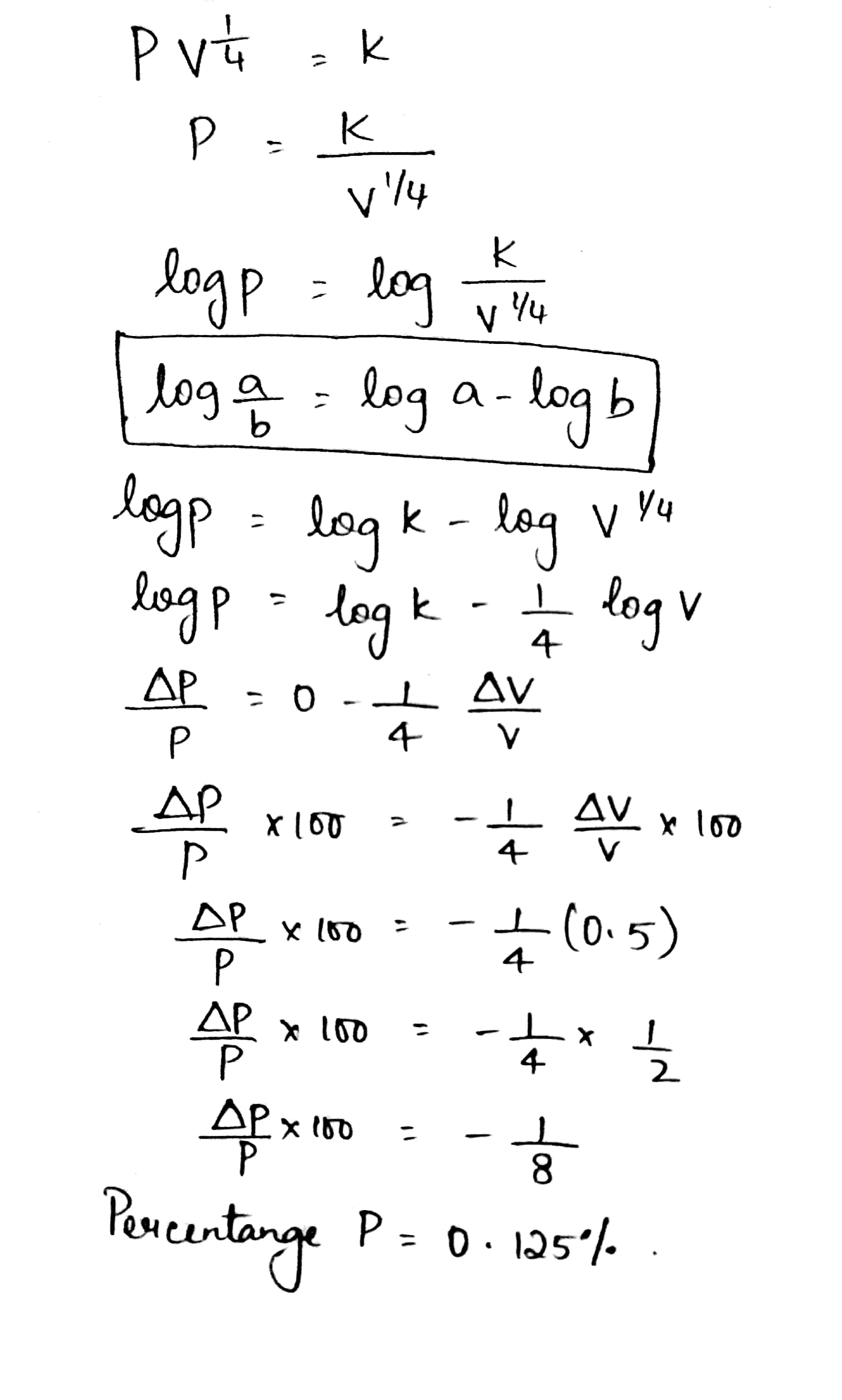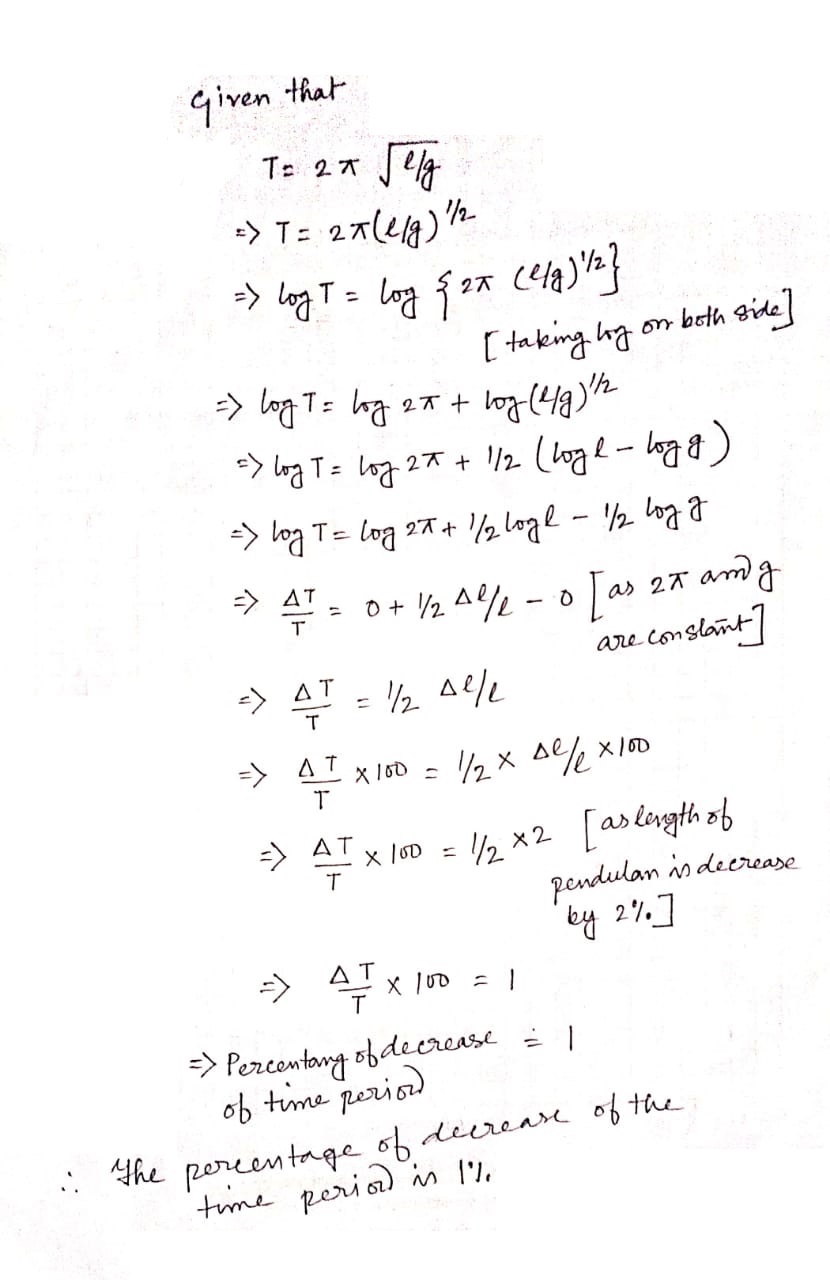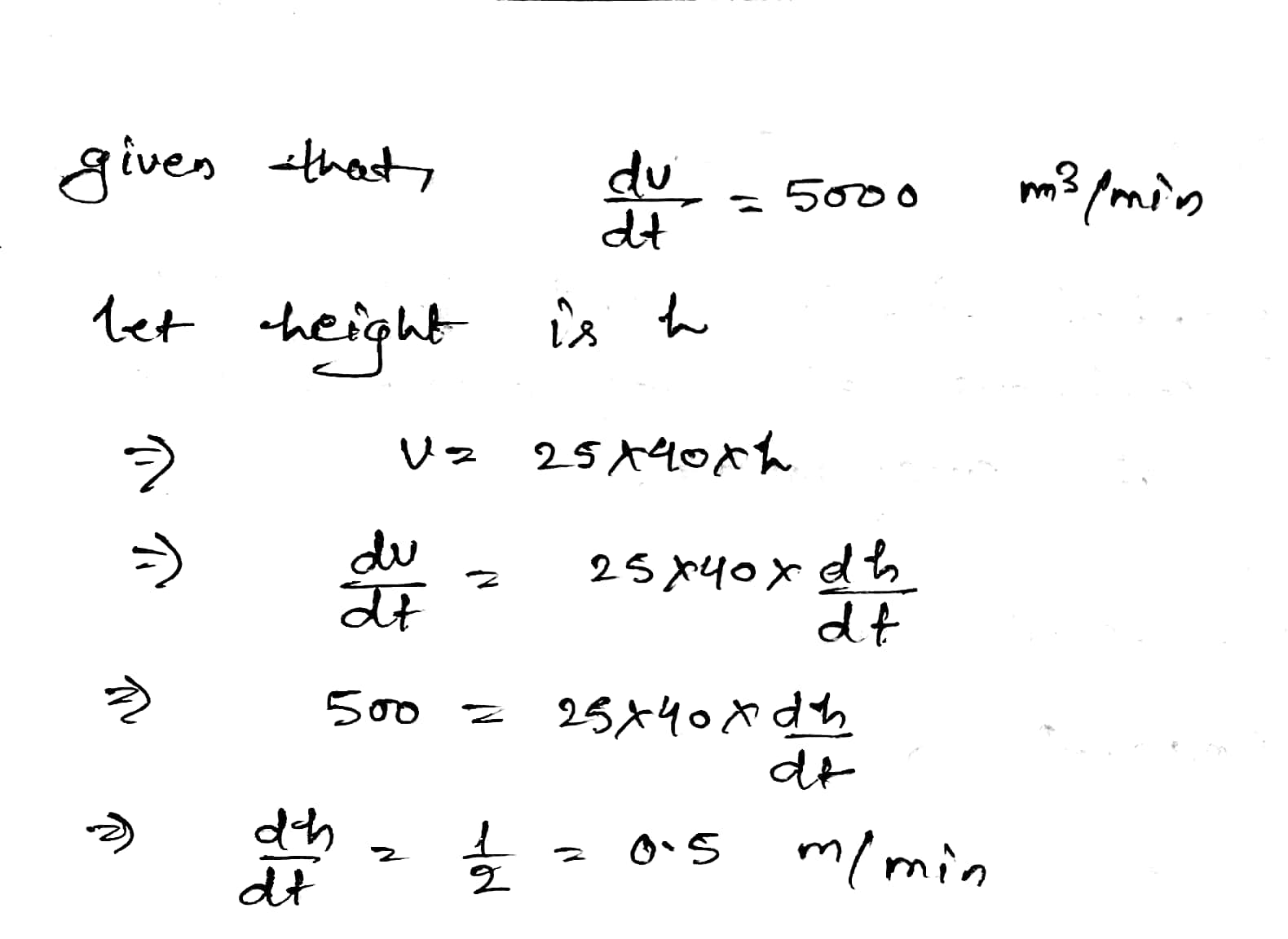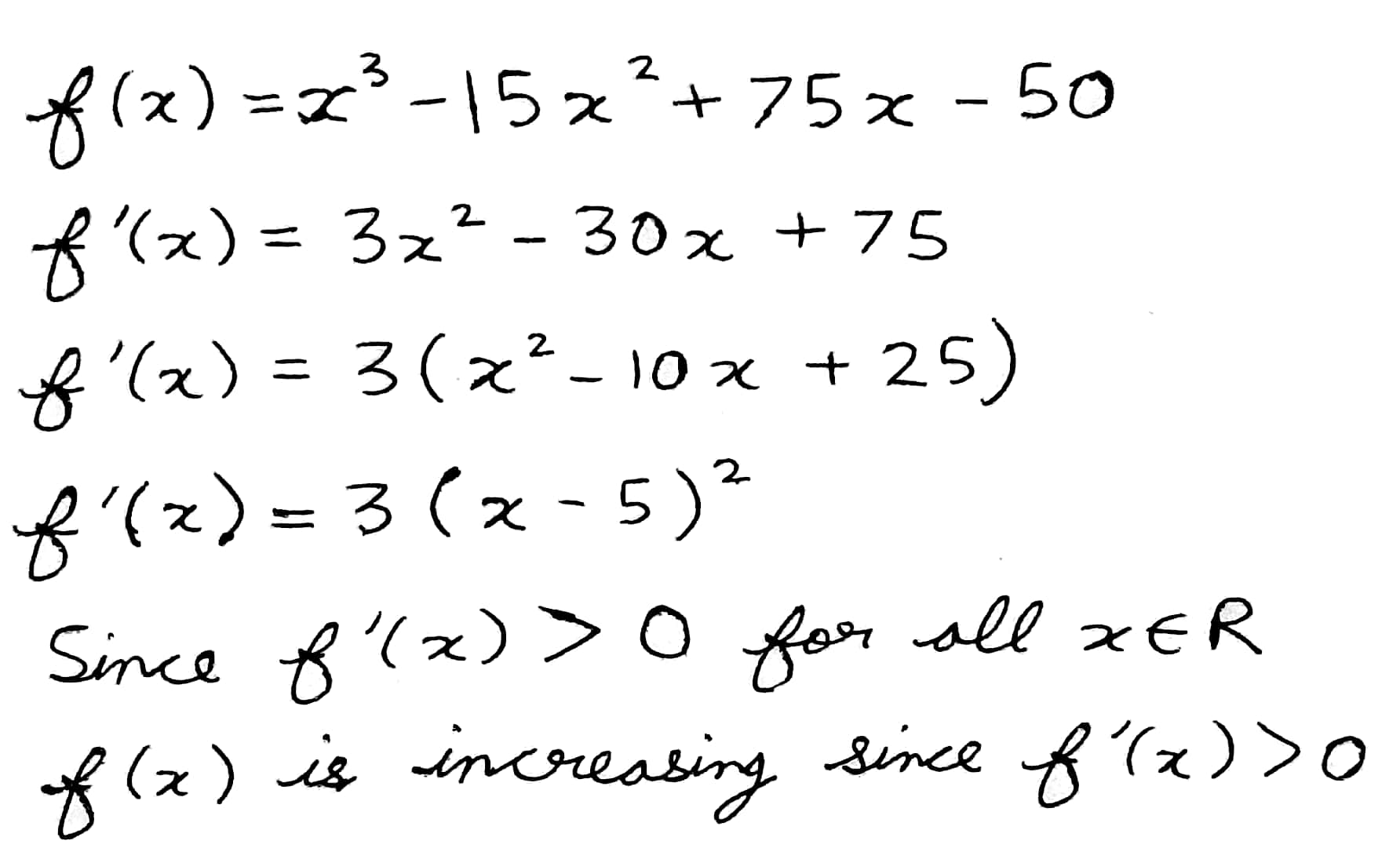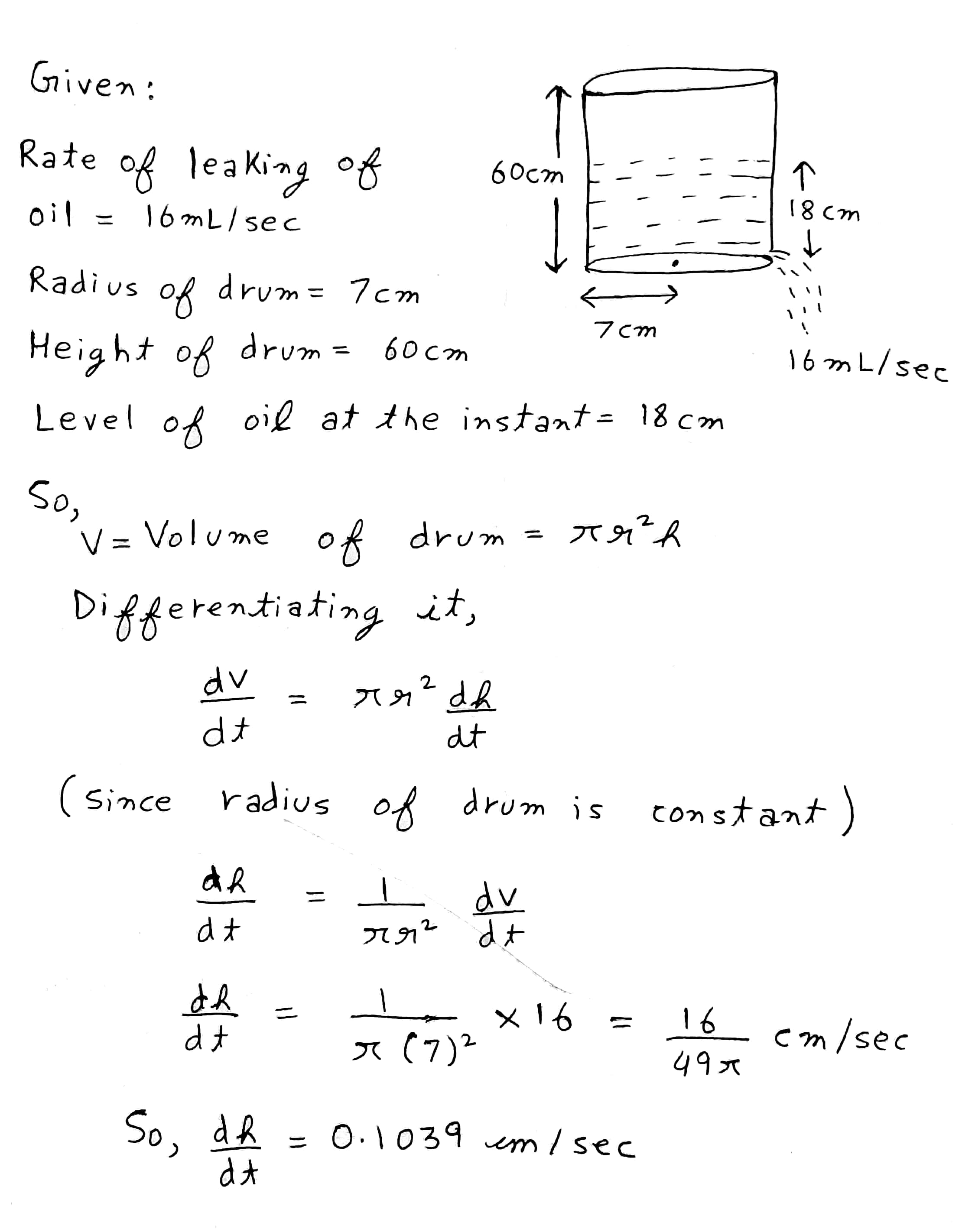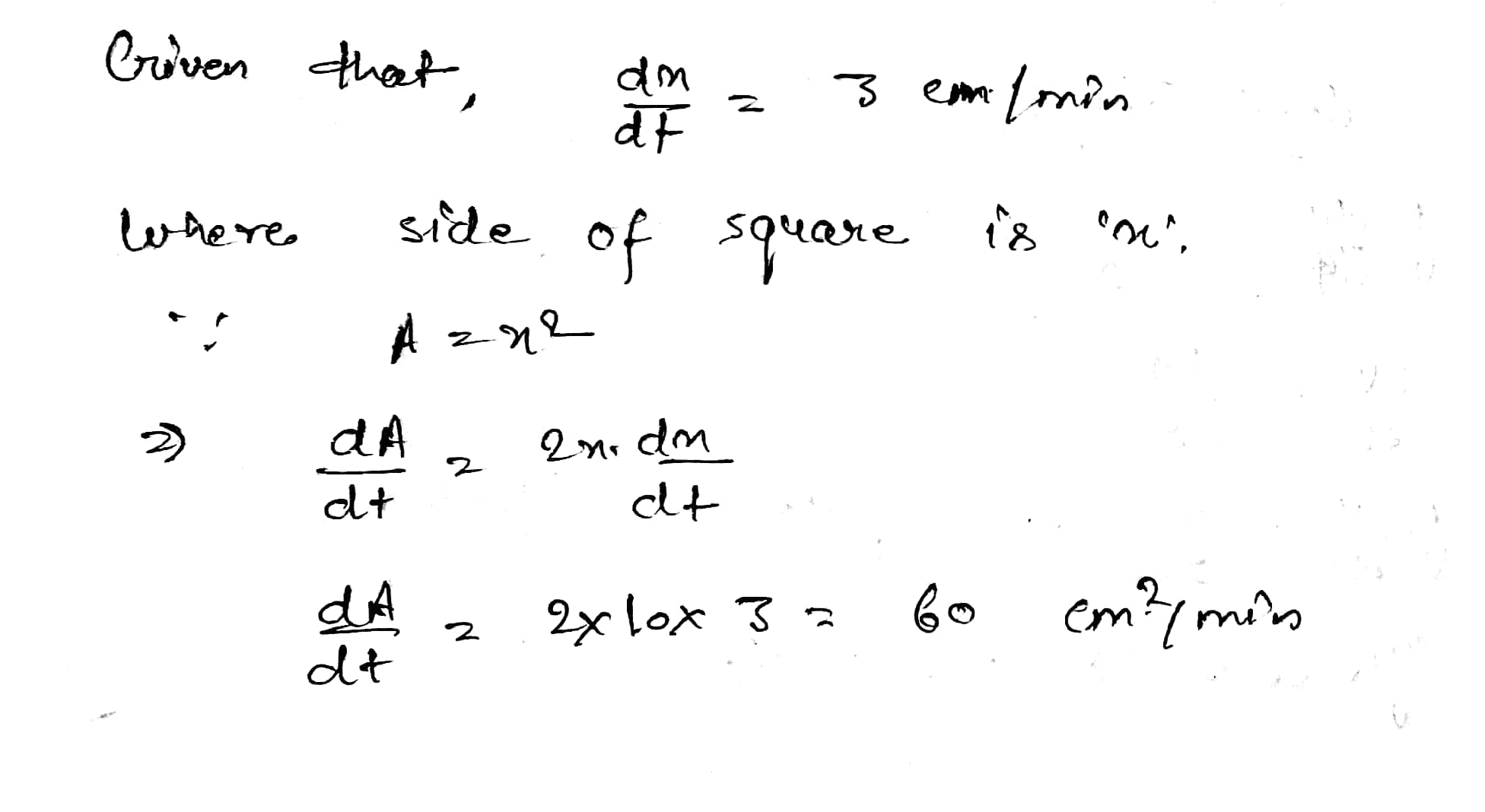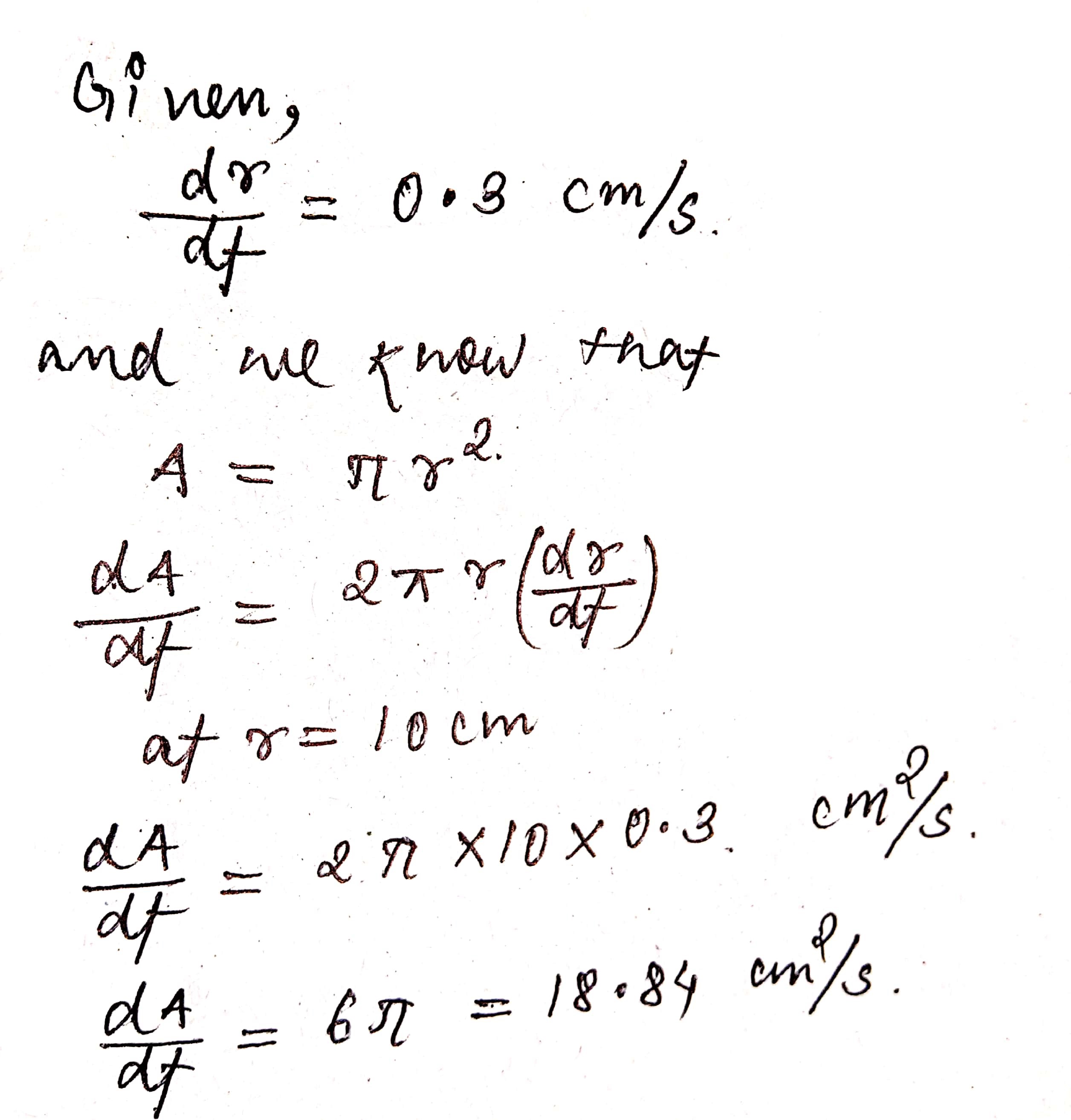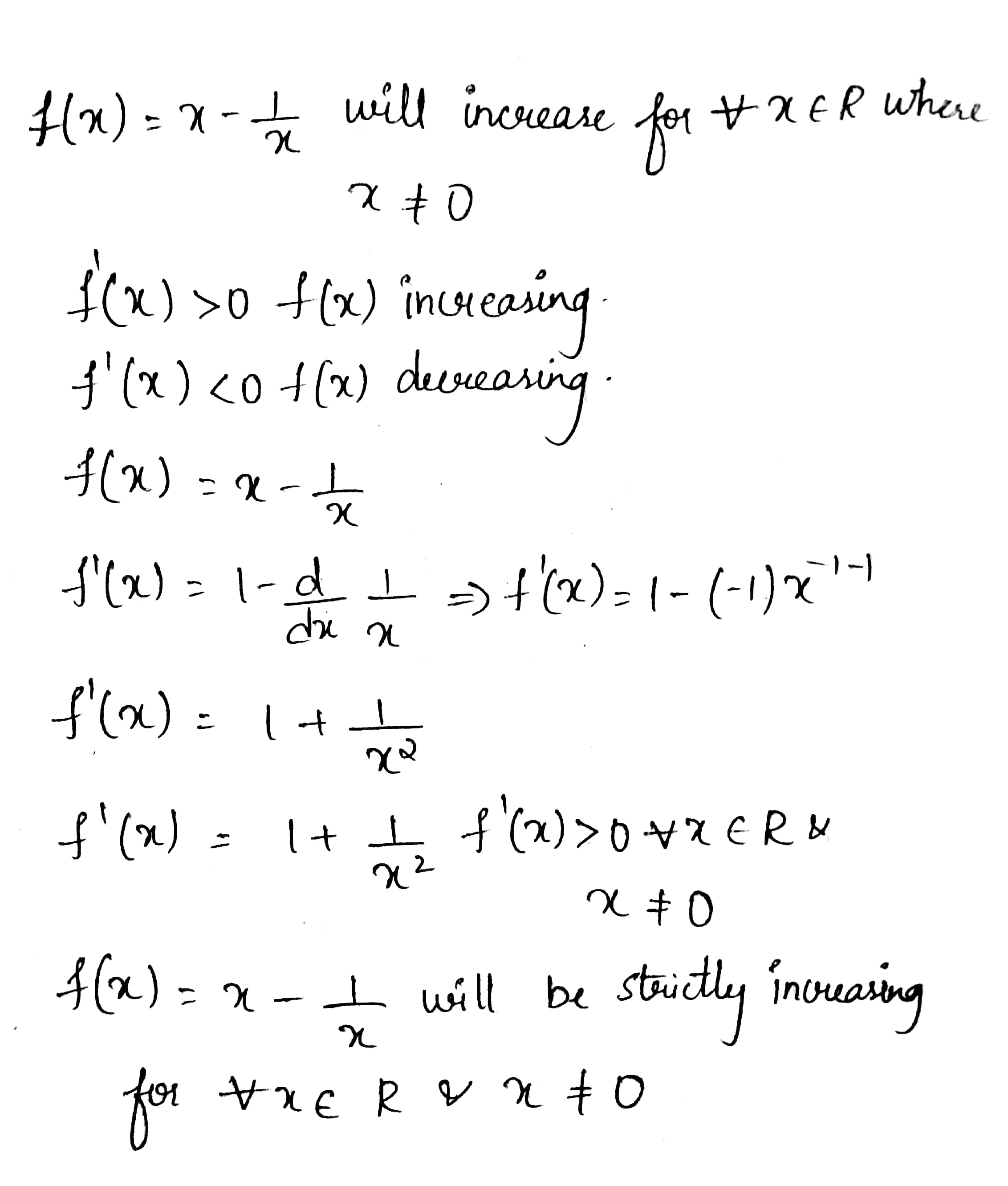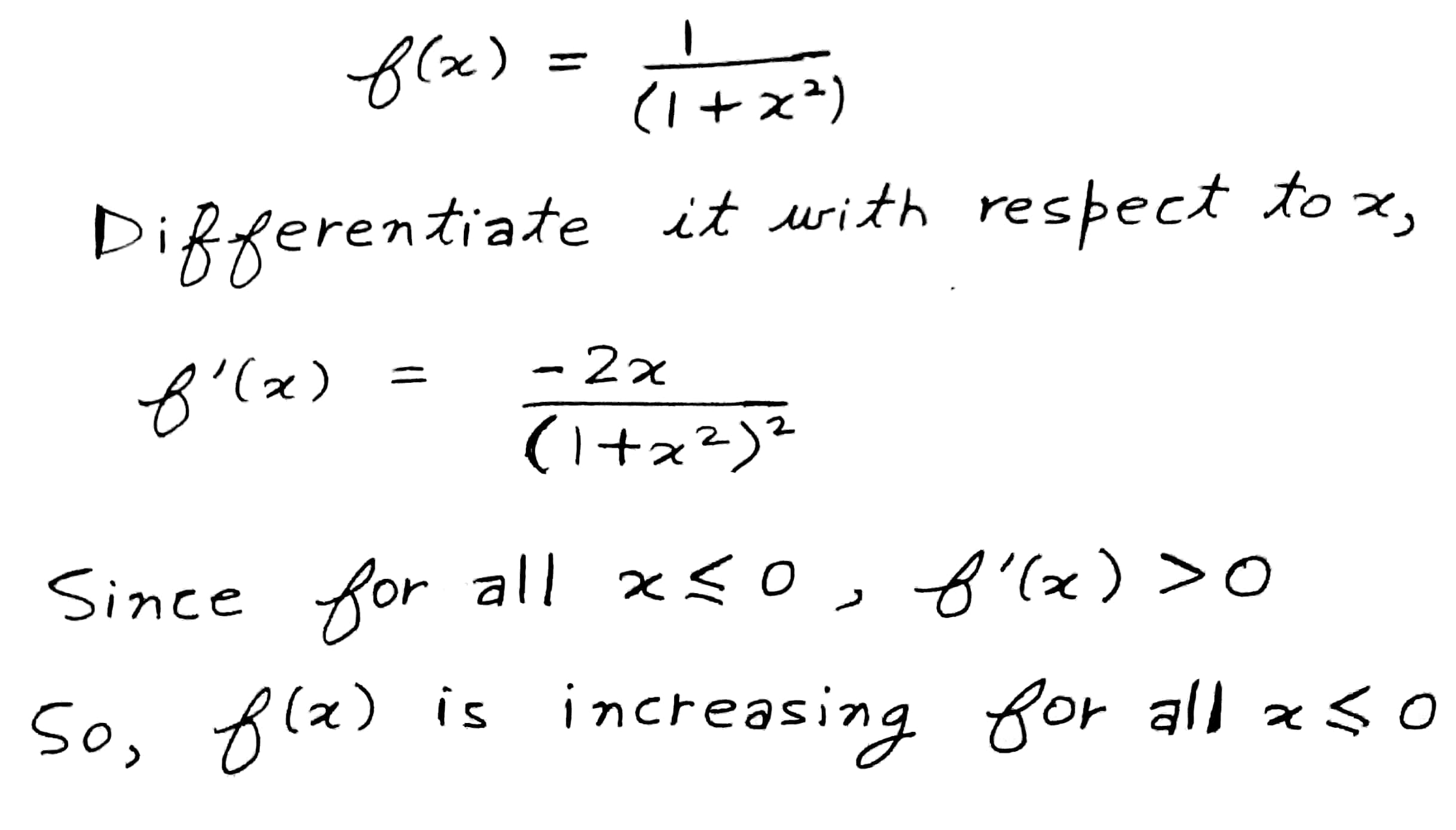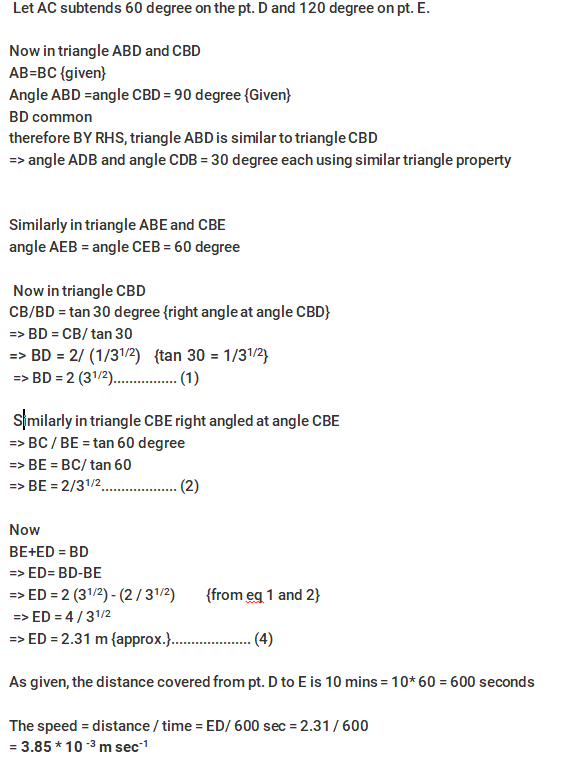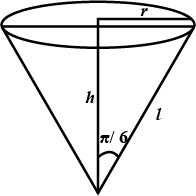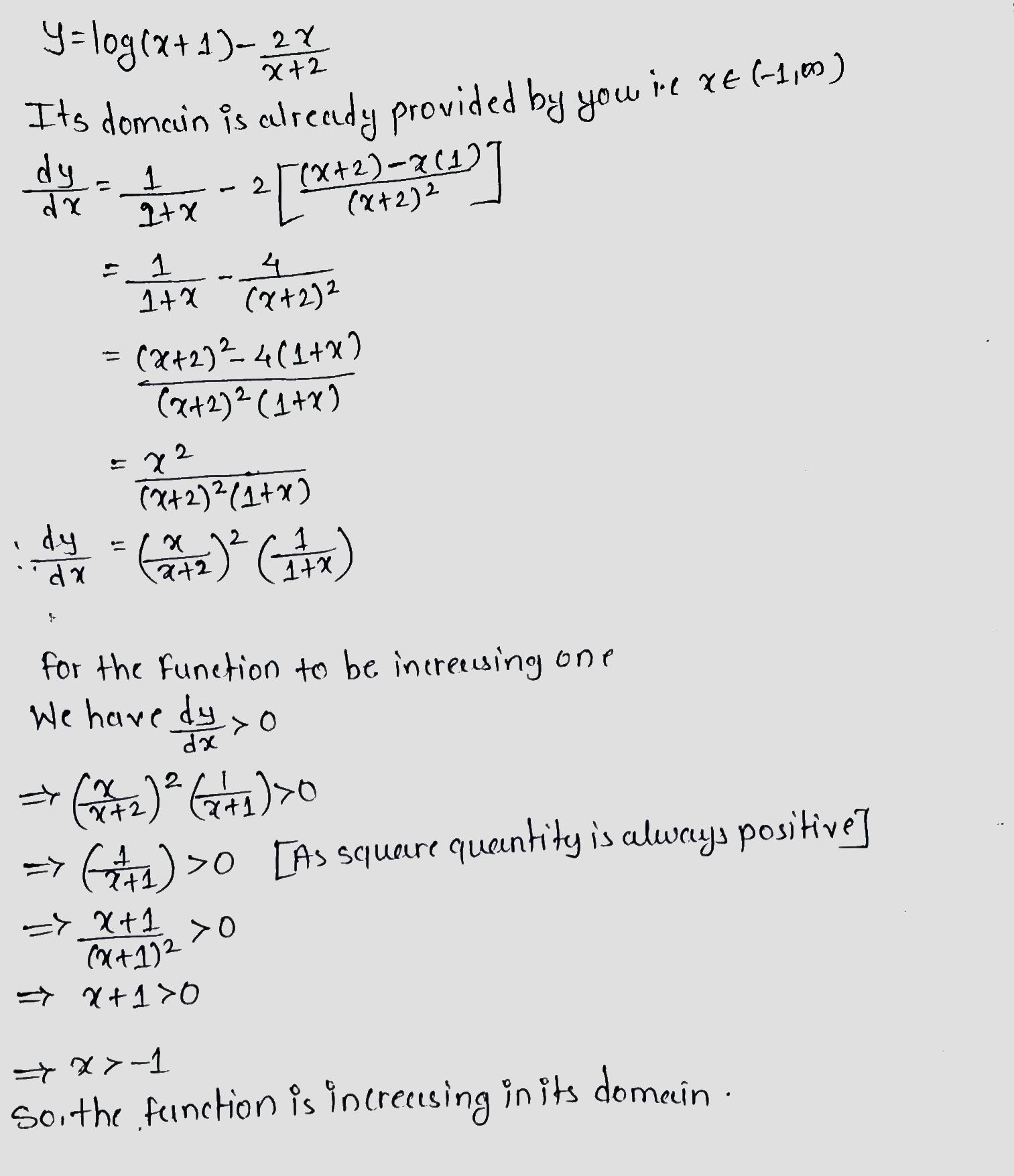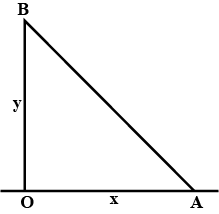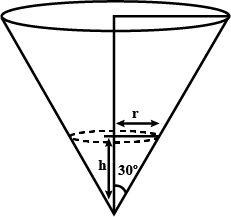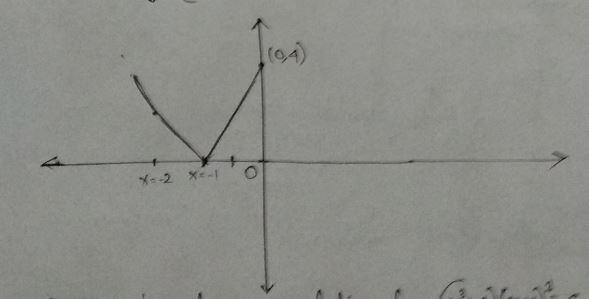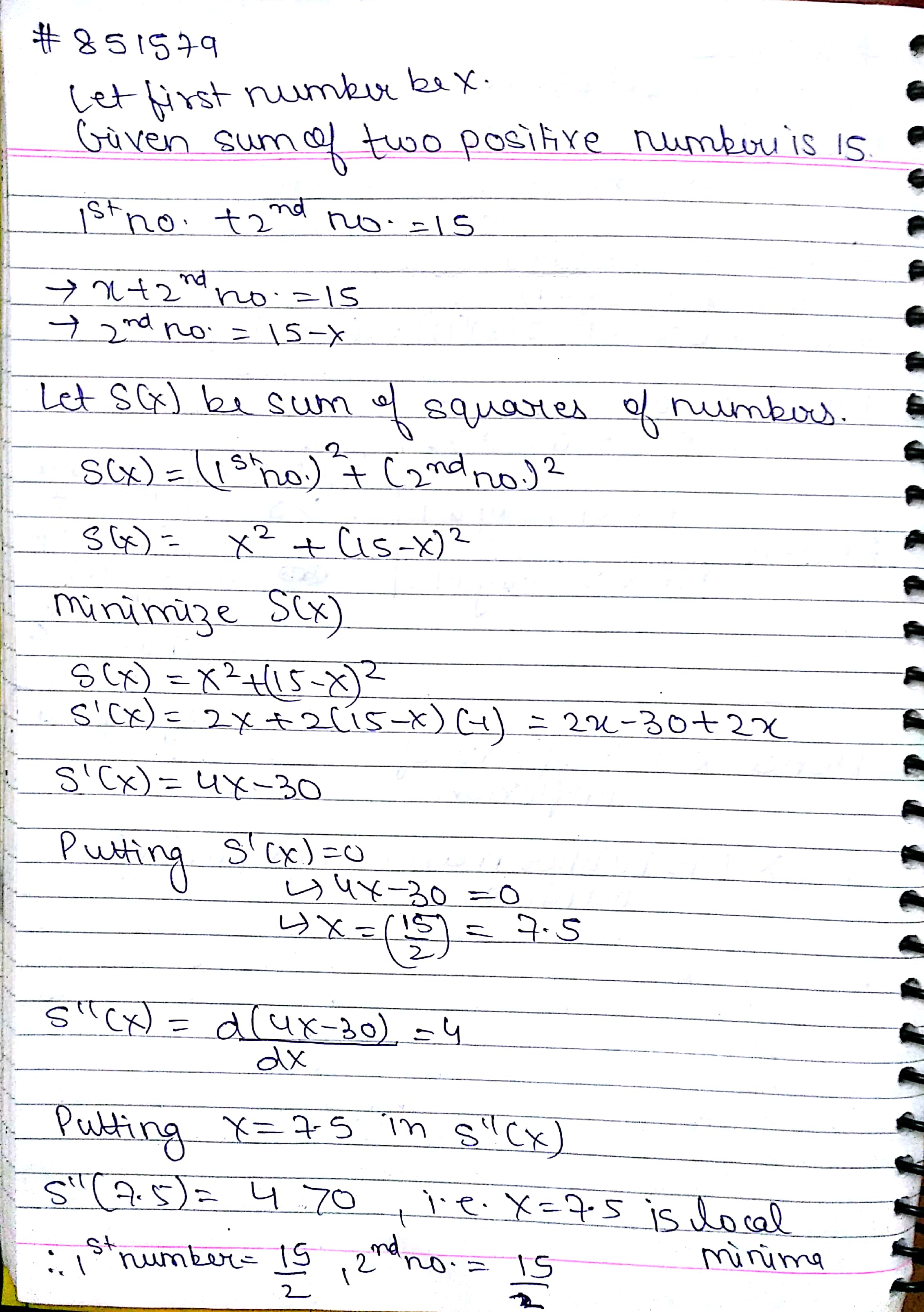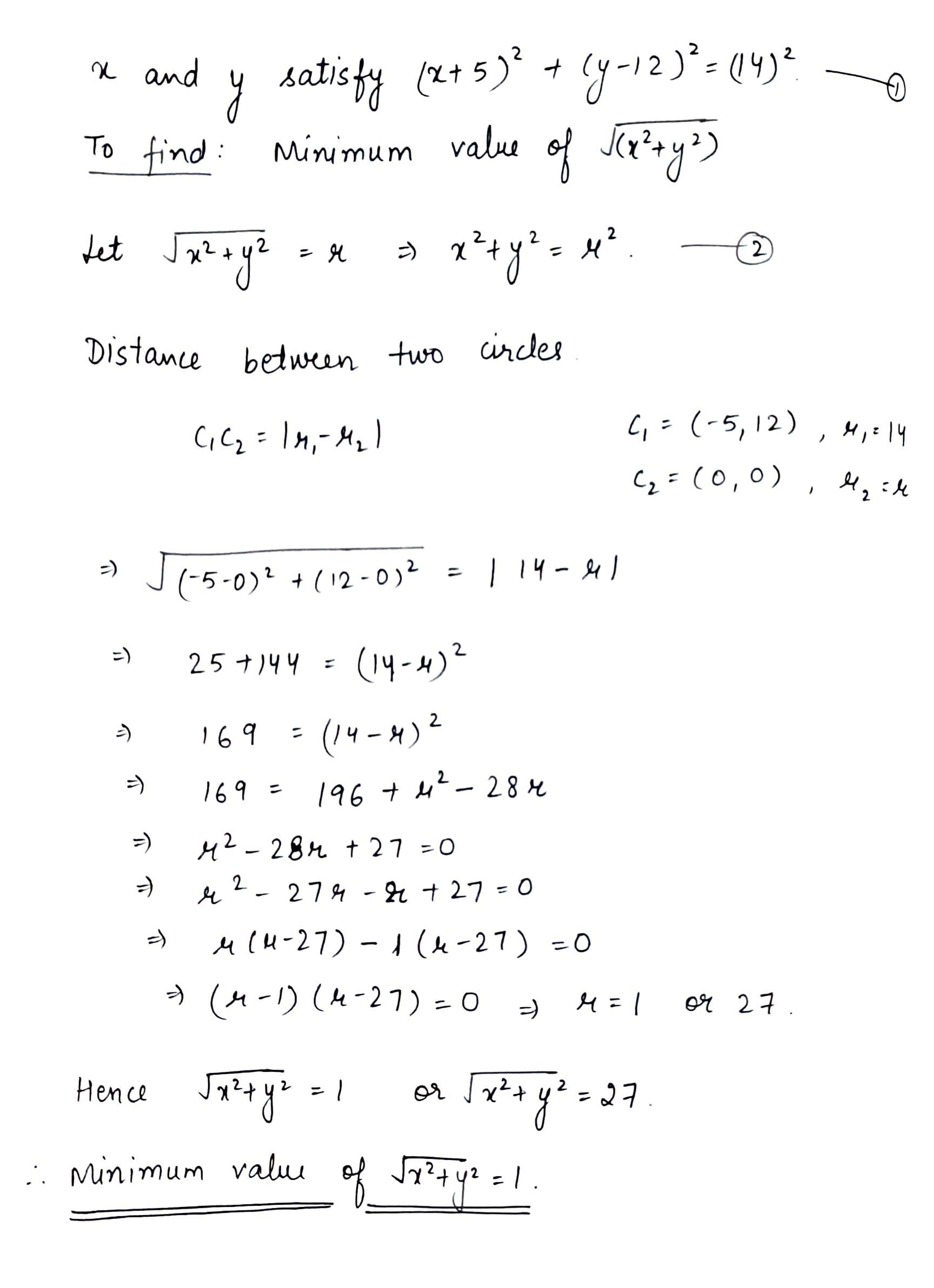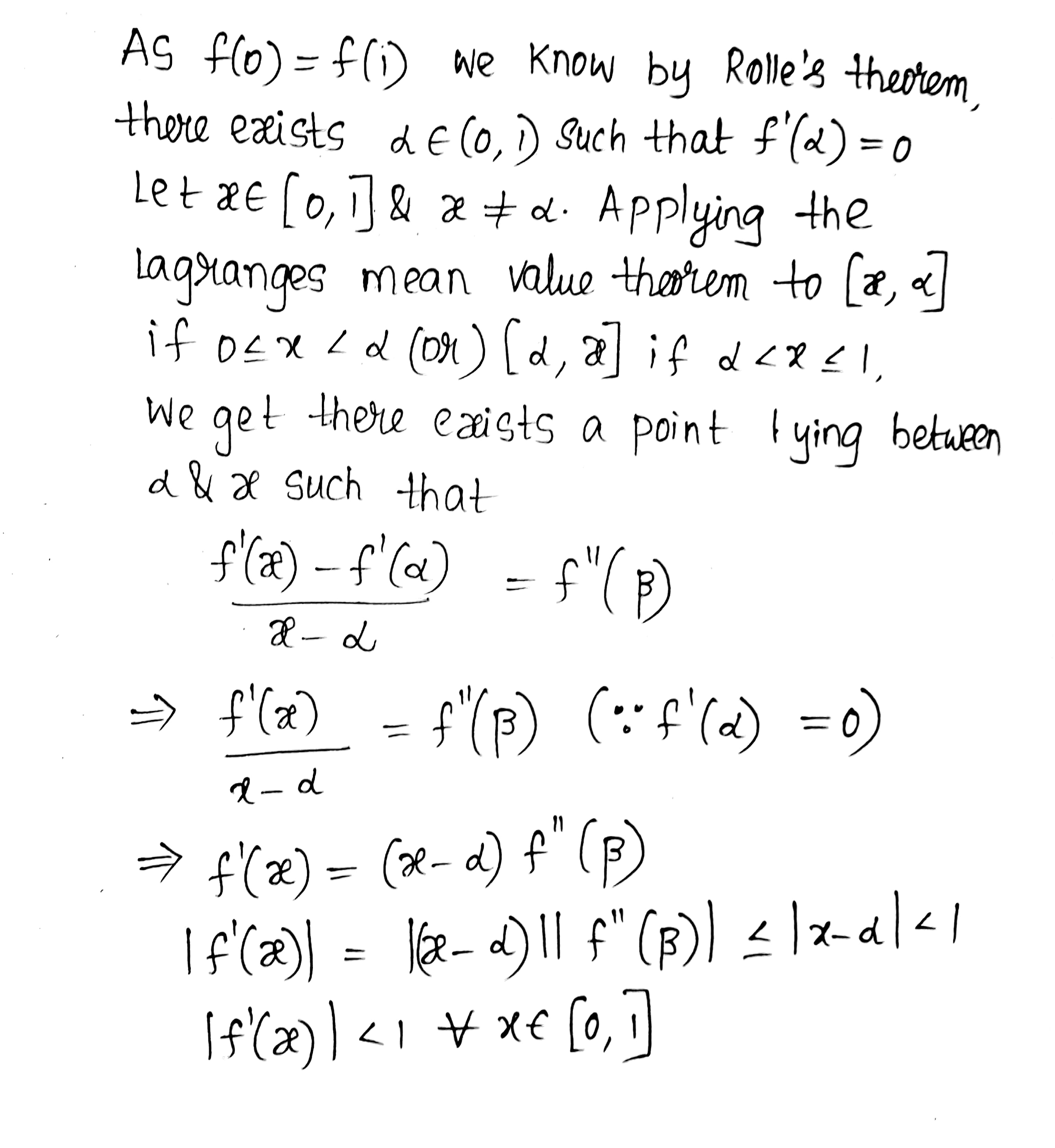Application Of Derivatives - Class 12 Commerce Applied Mathematics - Extra Questions
The total revenue in Rupees received from the sale of x units of a product is given by R(x)=13x2+26x+15.
Find the marginal revenue when x=7.
The total cost C(x) in Rupees associated with the production of x units of an item is given by C(x)=0.007x3−0.003x2+15x+4000.
Find the marginal revenue when x=17.
Solve: x4−x3+x2−x+1=0
Find real values of x for which, 27cos2x⋅81sin2x is minimum. Also find this minimum value.
Find the two positive numbers whose sum is 15 and sum of whose squares is minimum.
Find the values of k for which f(x)=kx3−9kx2+9x+3 is increasing on R.
An open can of oil is accidentally dropped into a lake; assume the oil spreads over the surface as a circular disc of uniform thickness whose radius increases steadily at the rate of 10 cm/sec. At the moment when the radius is 1 meter, the thickness of the oil slick is decreasing at the rate of 4mm/sec, how fast it is decreasing when the radius is 2 meters.
The displacement s of a moving particle at time t is given by s=5+20t−2t2. Find its acceleration when the velocity is zero.
The total cost C(x) associated with the production of x units of an item is given by C(x)=0.05x3−0.02x2+30x+5000. Find the marginal cost when 3 units are produced, where by marginal cost we mean the instantaneous rate of change of total cost at any level of output.
Rate of decay of a radioactive body is proportional to its mass pressure that time. After a decay of 1 hour the mass of body is 90 grams 2 hours it is 60 grams find the initial mass of the body.
A water tank is in the shape of an inverted cone. The radius of the base is 8 meters and the height is 12 meters. The tank is being emptied for cleaning at the rate of 4met3/minute. Find the rate at which the water level will be decreasing, when the water is 6 meters deep.
Find the interval of increase and decrease of the following functions.
f(x)=xlnx
The temperature of a body in a room is 100oF. After five minutes, the temperature of the body becomes 50oF. After another 5 minutes, the temperature becomes 40oF. What is the temperature of surroundings?
Find the interval of increase and decrease of the following functions.
f(x)=x2e−x
Find the rate of change of the volume of a sphere with respect to its diameter.
Show that f(x)=x2−xsin ,x is an increasing function on (0,π/2).
A particle moves along the x-axis obeying the equation x=t(t−1)(t−2), where x is in meter and t is in second
Find the time when the displacement of the particle is zero.
The radius of a circular plate is increasing at the ratio of 0.20 cm/sec.At what rate is the area increasing when the radius of the plate is 25 cm.
The displacement x of a particle moving in one dimension under the action of a constant force is related to time t by the equation t=√x+3, where x is in meter and t is in second. Find the displacement of the particle when its velocity is zero.
Water absorbs light. As depth increases, intensity of light decreases linearly. At 13.5 feet, water absorbs 50 percent of light which strikes the surface. At what depth would the light at noon be reduced by 13,00,000 of the noon light.
Prove that the following function do not have maxima or minima :f(x)=ex
The total cost C(x) and the total revenue R(x) associated with production and sale of x units of an item are given by C(x)=0.1x2+30x+1000 and R(x)=0.2x2+36x−100 . Find the marginal cost and the marginal revenue when x=20
Find the value of a if f(x)=2ex−ae−x+(2a+1)x−3 is increasing for all values of x.
Find the absolute maximum value and the absolute minimum value of the following function in the given interval :f(x)=(x−1)2+3,x∈[−3,1]
A circular disc of radius 3 cm is being heated. Due to expansion, its radius increases at the rate of 0.05 cm/s. Find the rate at which its area is increasing when radius is 3.2 cms.
Find the length of the perpendicular drawn from the origin on the tangent to the curve x=a(θ−sinθ),y=a(1−cosθ) at θ=π2.
The side of an equilateral triangle is increasing at the rate of 5cm/sec. At what rate its area increasing when the side of the triangle is 10 cm?
A helicopter is flying along the curve y=x2+2. A soldier is placed at the point (3,2), find the nearest distance between the soldier and helicopter.
Given f(x)=cos2x , find whether f(x) is increasing or decreasing in the range [0,π2].
find maximum and minimum value of sinxsin (60∘-x) sin(60∘+x).
With the help of graph,find the extreme value and where they occur.
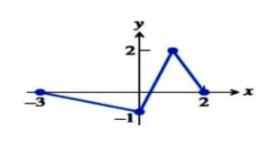
Prove that the function given by f(x)=cosx is strictly increasing in (π,2π).
Find dydx , if x23+y23=a23
Prove that the function given by f(x)=x3−3x2+3x−100 is inreasing in R.
Find the point on the curve y2=8x for which the abscissa and ordinate change at the same rate.
If x varies directly as y and when x is 3, y is 8, find y when x=21.
Find the absolute maximum and absolute minimum values of a function f given by f(x)=2x3−15x2+36x+1 on the interval [1, 5]
A particle moving in plane has the position (x,y) given by x=4+rcost and y=6+4sint where r is constant. Then find the velocity of the particle.
The radius of circular plate is 2 cm. If it is being heated the expansion in its radius happens at the rate of 0.02 cm/sec. Find the rate of expansion of the area when the radius is 2.1 cm.
Show that f(x)=11+x2 decreases in the interval [0,∞) and increases in the interval (−∞,0].
Determine whether f(x)=−x2+sinx is increasing or decreasing on (−π3,π3).
Find an angle θ,0<θ<π2, which increases twice as fast as its sine.
Show that f(x)=x+cosx−a is an increasing function on R for all values of a.
Show that sinpθcosqθ is maximum when θ=tan−1√p/q.
Show that the function f(x)=2x+cot−1x−log{x+√(1+x2)} is increasing ∀ R
y=sinx−asin2x−13sin3x+2ax, then y increases for all values of x if a>k., what is k?
If a and b are two parts of 8 such that sum of their cubes is the least possible then ab is equal to
Let x and y be two real variables such that x>0 and xy=1. Find the minimum value of x+y
The sum of two real numbers x and y is 20 If xy3 is greatest then the ratio x2:y2is1:λ Find the value of λ
The position vector of a particle at time 't' is given by →r=t2ˆt+t3ˆj . The velocity makes an angle θ with positive x-axis. Find the of dθdt at t=√23
Prove that the function f given by f(x)=logsinx is strictly increasing on (0,π2) and strictly decreasing on (π2,π)
Find the least value of a such that the function f given by f(x)=x2+ax+1 is strictly increasing on [1,2].
Let I be any interval disjoint from [−1,1]. Prove that the function f given byf(x)=x+1x is strictly increasing in interval disjoint from I.
For what value of x, 8x2−7x+2 has the minimum value?
Prove that the function given by f(x)=x3−3x2+3x−100 is increasing in R.
Prove that the function f given by f(x)=logcosx is strictly decreasing on (0,π2)and strictly increasing on (π2,π).
Find two positive numbers x and y such that their sum is 35 and the product x2y5 is a maximum.
Find two positive numbers whose sum is 16 and the sum of whose cubes is minimum.
In a bank, principal increases continuously at the rate of 5% per year. An amount of Rs.1000 is deposited with this bank, how much will it worth after 10 years(e0.5=1.648).
The volume of spherical balloon being inflated changes at a constant rate. If initially its radius is 3 units and after 3 seconds it is 6 units. Find the radius of balloon after t seconds.
A particle moves along the curve 6y=x3+2. Find the points on the curve at which the y-coordinate is changing 8 times as fast as the x-coordinate.
Find the numbers whose product is 100 and whose sum is minimum.
Find two positive numbers whose product is 64 and the sum is minimum.
A telephone company in a town has 5000 subscribers on its list and collects fixed rent charges of Rs.3,000 per year from each subscriber. The company proposes to increase annual rent and it is believed that for every increase of one rupee in the rent one subscriber will be discontinued. Find what increased annual rent will bring the maximum annual income to the company
If y=cos2(45o+x)(sinx−cosx)2 then the maximum value of y is:
Find the approximate changes in the volume 'V' of a cube of side x metres caused by decreasing the side by 1\%.
Prove that if x + y = 2 then maximum value of the functionary xy^{2} is \dfrac{32}{27}.
Show that f(x) = \dfrac{-x^{3}}{3} - x^{2} - x + 7 is always increasing in R.
When x is real, the greatest possible value of 10^{x} - 100^{x} is
Water is dripping out from a conical funnel of semi-vertical angle \displaystyle\frac{\pi}{4} at the uniform rate of 2 cm^2/sec in the surface, through a tiny hole at the vertex of the bottom. When the slant height of the water level is 4 cm, find the rate of decrease of the slant height of the water.
Find the intervals of increase and decrease of the, following functions.
\displaystyle\, f\, (x)\, = (2^x \, -\, 1)(2^x \, -\, 2)^2
A ladder 5 m long is leaning against a wall. The bottom of the ladder is pulled along the ground, away from the wall, at the rate of 2 cm/s. How fast is its height on the wall decreasing when the foot of the ladder is 4 m away from the wall?
Find the intervals in which the function f(x)=\displaystyle\frac{x^4}{4}-x^3-5x^2+24x+12 is
(a) strictly increasing, (b) strictly decreasing.
Find the greatest and the least values of the following functions.
\displaystyle y \, = \, x^3 \, + \, 4x^2 \, + \, 4x \, + \, 3 on the interval [-1, 3].
Find the least value of the function \displaystyle y \, = \, 7 \, + \, 3^x \, + \, 2.3^{3 \, - \, x} \, - \,x \, \ln \, 27 \, - \, 9.
Find all values of x for which the function \displaystyle\, y \,=\, \sin x \, \, \cos^2x\, -\, 1 assumes the least value. What is that value?
Find the greatest value of the function \displaystyle y \, = \, 7 \, + \, 2x \, \ln \, 25 \, - \, 5^{x \, - \, 1} \, - \, 5^{2 \, - \, x}.
For what value of x does the expression \displaystyle 2^{x^3} \, - \, 1 \, + \, \frac{1}{2^{x^3} \, + \, 2} assume the least value.
Find the greatest and the least values of the following functions.
\displaystyle f \, (x) \, = \, 2x^3 \, - \, 3x^2 \, - \, 12x \, + \, 1 on the interval [-1, 5].
Find the interval of increase and decrease of the following functions.
f(x) \, = \, x \, + \, \ln \, (1 \, - \, 4x)
Find the absolute maximum and minimum of function y=2\cos 2x-\cos 4x.
A particle starts from rest and its angular displacement (in rad) is given by \theta = \dfrac {t^{2}}{20} + \dfrac {t}{5}. If the angular velocity at the end of t = 4\ s is 'k'.Then, what will be the value '5k' ?
The total revenue R=720x-3{ x }^{ 2 } where x is the number of items sold. Find x for which total revenue R is increasing.
Sita is driving along a straight highway in her car. At time t = 0, when Sita is moving at 10\ ms^{-1} in the positive x-direction, she passes a signpost at x = 50\ m. Here acceleration is a function of time:
a = 2.0\ ms^{-2} - \left (\dfrac {1}{10} ms^{-3}\right )t
At what time is her velocity greatest?
Attempt the following:
The price P for demand D is given as P = 183 + 120D - 3D^2. Find D for which the price is increasing.
A particle starts with some initial velocity with an acceleration along the direction of motion. Draw a graph depicting the variation of velocity (v) along y-axis with the variation of displacement (s) along x-axis.
Find the values of x if f\left( x \right) =\cfrac { x }{ { x }^{ 2 }+1 } is
i) an increasing functionii) a decreasing function
A swimming pool is to be drained for cleaning. If L represents the number of liters of water in the pool t seconds after the pool has been plugged off to drain and L = 200 (10 - t)^2. What is the average rate at which the water flows out during the first 5 seconds \left(\dfrac{litres}{sec}\right)?
Find two number, such that their product is 64 and their sum is minimum.
\left[ {3\sin \theta + 4\cos \theta } \right] is maximum \left[ {given0 \le \theta \le {\pi \over 2}} \right] When \theta = ?
Determine the minimum value of the function:
f(x) = x^{2} +\frac{16}{x^{2}}
Let \left( x \right) = {{1 + \cos 2x + 8{{\sin }^2}x} \over {\sin 2x}},x \in \left( {0,{\pi \over 2}} \right). find minimum value of f\left( x \right)
A boat goes 60km upstream and downs stream in 6hr and 2\ hr respectively. Determine the product of speed of the stream and that of the boat in still water.
The minimum value of \dfrac{1}{3} (3\tan x + 27 \cot x) is.......
Find the intervals in which the function given by \ f(x)=\sin{x}-\cos{x}, -\pi \le x\le \pi is strictly increasing or decreasing ?
Prove that the function f defined by f(x)={x}^{2}-x+1 is neither increasing nor decreasing in (-1, 1). Hence find the intervals in which f(x) is strictly increasing and strictly decreasing.
Find the intervals in which the function f given byf\left( x \right) =\dfrac { 4\sin { x } -2x-x\cos { x } }{ 2+\cos { x } } is
(i) strictly increasing
(ii) strictly decreasing
Points A and B are 100\ km apart. a car starts from A and another from B at the same time. If they go in the same direction they meet in 5\ hr and if they go in opposites directions they meet in 1\ hr, find the product of their speeds.
The minimum value of \dfrac{1}{8}(16\csc^{2}x + 9\sin^{2}x) is...........
What is maximum value of 3-7\cos\ 5x?
If 0\lt \theta\lt \dfrac{\pi}{2} then prove that \dfrac{\sin \theta}{\theta} is decreasing.
Find the maximum and minimum value of \sin x\sin \left( {{{60}^0} - x} \right)\sin \left( {{{60}^0} + x} \right).
The length x of an rectangle is decreasing at the rate 2cm/sec and width y is increasing at the rate of 2 cm/sec. When x = 12 cm and y = 12 cm, the rate of change of the area of the rectangle is k {cm^2} /sec, then k - 9 is _________
A particle moves along the curve by 6y=x^{3}+2. Find the point on the curve at which the y-coordinates is changing 8 times as fast as the x- coordinate.
Determine two positive numbers whose sum is 24 and whose product is maximum.
A ladder 5 m long is leaning against a wall. The bottom of ladder is pulled along the ground, away from the wall, at the rate of 2 cm/s. How fast is its height on the wall decreasing when the foot of the ladder is 4 m away from the wall?
Find the absolute maximum and minimum values of the function f(x) = \dfrac{-1}{x^2} on [0.5, 2]
A stone is dropped into a pond. Waves in the form of circles are generated and the radius of the outermost ripple increases at the rate of 2 inch/sec when radius is 5 inch. Find the rate of increasing area.
A circular metal plate expands under heating so that its radius increases by 2\%. Using differentials find the approximate increase in the area of the plate if the radius of the plate before heating is 10\ cm.
A spherical raindrop evaporates at a rate proportional to its surface area. If originally its radius be 3\ mm and 1 hour later it reduces to 2\ mm, find an expression for the radius of the rain drop at any time t.
A street light is 6\ m high. A man 180\ cm tall goes away from the street light at the speed of 120\ cm/sec. Find the rate of increase of length of his shadow when he is 9\ m away from the light. Also find the rate at which the tip of the shadow moves on the road.
Show that f(x)=\dfrac{x}{1+x\tan{x}}, \ x\ \epsilon \ (0,\dfrac{\pi}{2}) is maximum when x=\cos{x}
If a point moves along the curve y^{2}=x, At what point on the curve does the y coordinate change at the same rate as the x coordinate.
Water is running into a conical vessel 15\ cm deep and 5\ cm in radius, at the rate of 0.1\ cm^{3}/s, when the water is 6\ cm deep, find at what rate is
i) the water level is rising
ii) the water surface area increasing
iii) the welted surface of the vessel increasing.
A stone dropped into a pond of still water sends out concentric circular waves from the point of disturbance of water at the rate of 4\ cm/sec. Find the rate of change of disturbed area at the instant when the radius of wave ring is 15\ cm.
Resistance to motion, F, of a moving vehicle is given by, F=\dfrac{5}{x}+100x. Determine the minimum value of resistance.
Show that f(x)=x^{3}-6x^{2}+18x+5 is an increasing function for all x\epsilon R.
Let A = R - \left\{ 3 \right\},\,B = R - \left\{ 1 \right\}, and let f:A \to B be defined by f\left( x \right) = \dfrac{{x - 2}}{{x - 3}}. Check the nature of function.
If the function f(x)=2x^{3}-9mx^{2}+12m^{2}x+1, where m>0 attains its maximum and minimum at p and q respectively such that p^{2}=q, then find the value of m.
Find about maxima & minima f(x)=2x^{3}-15x^{2}+36x+1
The radius of a sphere shrinks from 10cm to 9.8cm. Find approximate error in its volume.
A rectangular tank is 80m long and 25m broad. Water flows into it through a pipe whose cross-section is 25{cm}^{2}, at the rate of 16km per hour. How much the level of the water rises in the tank in 45 minutes?
The wheel of a motor cycle is of radius 35 cm. How many revolutions per minute must the wheel make so as to keep a speed of 66 km/hr?
If x=a(cos2t+2t\sin2t) and y=a(\sin 2t-2t\cos 2t) then find \dfrac {d^{2}y}{dx^{2}}
Find intervals in which the function given by f\left( x \right) =\dfrac { 3 }{ 10 } { x }^{ 4 }-\dfrac { 4 }{ 5 } { x }^{ 3 }-{ 3x }^{ 2 }+\dfrac { 36 }{ 5 } x+11 is (a) strictly increasing (b) strictly decreasing.
The volume of a cubic is increasing at a rate of 9 cubic centimetres per second. How fast is the surface area increasing when the length of an edge is 10\ cm.
The rate of growth of bacteria is proportional to the number present. If initially, there were 1000 bacteria and the number doubles in 1 hour, find the number of bacteria after 2 \dfrac{1}{2} hours. [Take \sqrt{2} = 1.414]
Find the absolute maximum/minimum value of following function.
f(x)=\sin x+\cos x; x in [0, \pi].
Find the intervals in which the function f(x) is (i) increasing, (ii) decreasing
f(x) = 2x^3 - 9x^2 + 12x + 15
Determine the intervals in which the function f (x)={ x }^{ 4 }-{ 8x }^{ 3 }+{ 22x }^{ 2 }-24x+ 21 is strictly increasing or strictly decreasing.
Suppose that a moth- ball loses volumes by evaporation at a rate proportional to its instantaneous surface area . If radius of the ball decreases from 2cm to 1 cm in 3 months, how long will it take until the ball has practically gone?
The min value of x^2-7x+10=0
Find the minimum value of (ax+by), where xy=c^{2}.
The side of a square sheet is increasing at the rate of 4 cm per minute. At what rate is the area increasing when the side is 8 cm long?
Show that f(x)={e}^{1/x}, x\ne 0 is a decreasing function for all x\ne 0.
The radius of a spherical soap bubble is increasing at the rate of 0.2 cm/sec. Find the rate of increase of its surface area, when the radius is 7 cm.
The volume of a spherical balloon is increasing at the rate of 25 cubic centimetre per second. Find the rate of change of its surface area at the instant when radius is 5\ cm.
Show that the function f(x)={\cot}^{-1}(\sin x+\cos x) is decreasing on \left (0,\dfrac {\pi }{4}\right) and increasing on \left (\dfrac {\pi }{4},\dfrac {\pi }{2}\right).
Show that f(x)={\tan}^{-1}(\sin x+\cos x) is a decreasing function on the interval \left (\dfrac {\pi }{4},\dfrac {\pi }{2}\right).
Show that f(x)=\sin x is an increasing function on \left (-\dfrac {\pi }{2},\dfrac {\pi }{2}\right)
Show that f(x)=\log \sin x is increasing on \left (0,\dfrac {\pi }{2}\right) and decreasing on \left (\dfrac {\pi }{2},\pi\right).
Show that f(x)={x}^{3}-15{x}^{2}+75x-50 is an increasing function for all x\in R.
Prove that the function f given by f(x)=x-\left[ x \right] is increasing in (0,1).
Prove that the following functions are increasing on R:
(i) f(x)=3{x}^{5}+40{x}^{3}+240x
(ii) f(x)=4{x}^{3}-18{x}^{2}+27x-27
Show that f(x)=\log _{ a }{ { x }_{ } } , 0< a< 1 is a decreasing function for all x> 0.
A balloon in the from of a right circular cone surmounted by a hemisphere, having a diameter equal to the height of the cone, is being inflated. How fast is its volume changing with respect to its total height h, when h = 9 cm?
Show that f(x)={\tan}^{-1}x-x is a decreasing function on R.
Find the intervals in which f(x) is increasing or decreasing:
(i) f(x)=x\left| x \right| ,x\in R
(ii) f(x)=\sin x+\left| \sin x \right| , 0< x\le 2\pi
(iii) f(x)=\sin x(1+\cos x), 0< x< \cfrac{\pi}{2}
Find the values of a for which the function f(x)=\sin x-ax+4 is increasing function on R.
Divide 64 into two parts such that the sum of the cubes of two parts is minimum.
Find the point on the curve y^2=2x which is at a minimum distance from the point (1, 4).
Find the derivative of f(x)=x^2-2 at x=10.
The surface area of a spherical balloon is increasing at the rate of 2cm^2/sec. At what rate the volume of the balloon is increasing when the radius of the balloon is 6 cm ?
The least vlue of the function f(x) = ax + \dfrac{b}{x} (a > 0, \,b> 0, \,x > 0) is _____
The radius of a circle is increasing at the rate of 0.7\ cm/s. What is the rate of increases of its circumference ?
The radius of a sphere shrinks from 10\ cm to 9.8\ cm. Find approximately the decrease in (i) volume, and (ii) surface area.
The pressure p and volume V of gas are connected by the relation, pV^{1/4}=k, where k is a constant. Find the percentage increase in the pressure, corresponding to a diminution of 0.5\% in the volume.
If the length of a simple pendulum is decreased by 2\%, find the percentage decrease in its period T, where T=2\pi \sqrt{\dfrac{l}{g}}.
The bottom of a rectangular swimming tank is 25\ m by 40\ m. Water is pumped into the tank at the rate of 500 cubic metres per minute. Find the rate at which the level nof water in tank is rising.
Show that f(x)=x^3-15x^2+75x-50 is increasing on R.
Oil is leaking at the rate of 16\ ml/s. from a vertically kept cylindrical drum containing oil. If the radius of the drum is 7\ cm and its height is 60\ cm, find the rate at which the level of the oil is changing when the oil level is 18\ cm.
The side of a square sheet of metal is increasing at 3 centimetre per minute. At what rate is the area increasing when the side is 10\ cm long?
The radius of a circle is increasing uniformly at the rate of 0.3 centimetre per second. At what rate is the area increasing when the radius is 10\ cm? (Taken \pi = 3.14.)
Show that f(x)=\left(\dfrac{3}{x}+5\right) is decreasing for all x\in R, wherer x\neq 0.
Show that f(x)=\left(x-\dfrac{1}{x}\right) is increasing for all x\in R, where x\neq 0.
Show that f(x)=\dfrac{1}{(1+x^2)} is increasing for all x\le 0.
On a straight coast there are three objects A, B, and C such that AB = BC = 2\ miles. A vessel approaches B in a line perpendicular to the coast and at a certain point AC is found to subtend an angle of 60^{\circ}; after sailing in the same direction for ten minutes AC is found to subtend 120^{\circ}, find the rate at which the ship is going.
Find the required for a cylindrical tank of radius r and height H to empty through a round hole of area 'a' at the bottom. The flow through a hole is according to the law U(t)=u \sqrt {2gh (t)} where v(t) and h(t) are respectively the velocity of flow through the hole and the height of the water level above the hole at time t and g is the acceleration due to gravity.
Determine for which values of x the function y = x^4 - \dfrac {4x^3}{3} is increasing and for which values it is decresing.
Water is dripping out at a steady rate of 1 cu \quad cm/sec through a tiny hole at the vertex of the conical vessel, whose axis is vertical. When the slant height of water in the vessel is 4 cm , find the rate of decrease of slant height, where the vertical angle of the conical vessel is \frac{\pi}{6}.
Show that y= log(1+x)- \dfrac{2x}{2+x}, x> is an increasing function of x throughout its domain.
The values of a for which the function f\left( x \right) =sin x-ax+b increases on R are_____.
A ladder 10 metres long is leaning against a vertical wall. If the bottom of the ladder is pulled horizontally away from the wall at the rate of 1.2 ,meters per second, find how fast the top of the ladder is sliding down the wall, when the bottom is 6 metres away from the wall.
Solve the following: A water tank in the farm of an inverted cone is being emptied at the rate of 2 cubic feet per second. The height of the cone is 8 feet and the radius is 4 feet. Find the rate of change of water level when the depth is 6 feet.
If watverted hollow cone whose semi-vertical angle is 30^o, so that its dept (measured along the axis) increases at the rate of \dfrac{1\ cm}{sec}. Find therate at which the volume of water increasing when the depth is 2\ cm
The volume of a sphere increases at the rate of \dfrac{20cm^3}{sec}. Find the rate of change of its surface area, when its radius is 5\ cm.
The edge of a cube is decreasing at the rate of \dfrac{0.6 cm}{sec}. Find the rate at which its volume is decreasing, when the edge of the cube is 2\ cm.
A spherical soap bubble is expanding so that its radius is inreasing at the rate of 0.02\ cm/sec. At what rate is the surface area increasing, when its radius is 5\ cm?
The length x of a rectangle is decreasing at the rate of5cm/minute and the width y is increasing at the of 4 cm / minute . When x = 8cm and y = 6 cm , find the rates of change of the area of the rectangle .
Show that y = log (1 + x ) - \dfrac{2x}{2 + x} , x > -1 an increasing function of x throughout its domain .
A stone is dropped into a quiet lake and waves move in circles at the speed of 5 cm / s.. At the instant when the radius of the circular wave is 8 cm , how fast is the enclosed area increasing ?
A ladder 5 in long is leaning against a wall. The bottom of the ladder is pulled along the ground , away from wall, at the rate of 2 cm / s . How fast is its height on the wall decreasing when the foot the ladder is 4 m away from the wall?
A balloon, which always remains spherical on inflation , is being inflated by pumping in 900 cubic centimetres of gas per second. Find the rate at which the radius of the balloon increases when the radius is 15 cm .
Find the values of x for which y = [ x (x - 2 ) ] ^{2} is an increasing function
A balloon , which always remains spherical , has a variable diameter \dfrac{3(2x+1)}{2} . Find the rate of changes of its volume with respect to x .
A Balloon which is always spherical, is being inflated by pumping in 900 cm^3 of gas per second. Find the rate at which the radius of the balloon is increasing when the radius is 15 cm.
A balloon which is always spherical, has diameter \frac{3}{2} (2x + 1) Find rate of change of its volume w.r.t.x.
If radius and height of a cylinder is r and A, then find the rate of change of surface area with respect to its radius.
Find the value of x and y for function, y = x^3 + 21 where, the rate of change ofy is three times as the rate of change of x.
If \displaystyle f\left ( x \right )= \cos \left ( 2x+\frac{\pi }{4} \right ) then show that f(x) is increasing in the interval \displaystyle \frac{3\pi }{8}< x< \frac{7\pi }{8}
If u(x) is larger of \displaystyle x-\left ( x^{3}/6 \right ) and \displaystyle \tan^{-1}x for \displaystyle 0 < x \leq 1 then 48u(1/2) is equal to
Investigate the behaviour of the function y\, =\, (x^3\, +\, 4)(x\, +\, 1)^3 and construct its graph. How many solutions does the equation (x^3\, +\, 4)(x\, +\, 1)^3\, =\, c possess ?
In a bank, principal increase continuously at the rate of r% per year. Find the value of r if Rs. 100 double itself in 10 years (log_e 2=0.6931)
In a culture, the bacteria count is 1,00,The number is increased by 10% in 2 hours. In how many hours will the count reach 2,00,000, if the rate of growth of bacteria is proportional to the number present?
Prove that \displaystyle y=\dfrac { 4\sin { \theta } }{ 2+\cos { \theta } } is an increasing function of \displaystyle \theta on \displaystyle \left[ 0,\dfrac { \pi }{ 2 } \right] .
The population of a village increases continuously at the rate proportional to the number of its inhabitants present at any time. If the population of the village was 20,000 in 1999 and 25000 in the year 2004, what will be the population of the village in 2009?
It is given that the graph of y = x^4+ax^3+bx^2+cx+d (where a, b, c, d are real) has at least 3 points of intersection with the x-axis. Prove that either there are exactly 4 distinct points of intersection, or one of those 3 points of intersection is a local minimum or maximum.
A cylindrical water tank of diameter 1.4\ m and height 2.1\ m is being fed by a pipe of diameter 3.5\ cm through which water flows at the rate of 2\ m/s. Calculate the time, it takes to fill the tank.
Find 2 +ve nos. whose sum is 15 and the sum of whose squares is min.
Find two positive numbers x and y such that x+y=60 and xy^3 is maximum.
The sum of two positive numbers is 12 and sum of one and product of one and sqaure of the other is maximum.Find the numbers.
The radius of the soap bubble is increasing at the rate of 0.2 cm/sec. If its radius is 5 cm, find the rate of increasing of its volume.
If water is poured into an inverted hollow cone whose semi-vertical angle is {30^ \circ } , and its depth (measured along axis) increase at the rate of 1 cm per sec, find the rate at which the volume of water is increasing when the depth is 24 cm.
Find the points of absolute maximum and minimum of f (x) = (x - 1)^{1/3} \,\, (x - 2); \,\, 1 \le x \le 9.
If \theta \in \left[ {\dfrac{{5\pi }}{{12}},\, - \dfrac{\pi }{3}} \right] and mamimum value of \dfrac{{\tan \left( {\theta + \frac{{2\pi }}{3}} \right) - \tan \left( {\theta + \dfrac{\pi }{6}} \right) + \cos \left( {\theta + \frac{\pi }{6}} \right)}}{{\sqrt 3 }} is \frac{a}{b} (where a and b are co-primes),then a-b is equal to _________________
Find all the points of local maxima and local minima of the function
f(x) =-\dfrac{3}{4}x^4-8x^3-\dfrac{45}{2}x^2+105.
If real number x and y satisfy {\left( {x + 5} \right)^2} + {\left( {y - 12} \right)^2} = {\left( {14} \right)^2} then the minimum value of \sqrt {\left( {{x^2} + {y^2}} \right)} is
At noon, ship A is 170\ km west of ship B. Ship A is sailing east at 40\ km/h and ship B is sailing north at 25\ km/h. How fast is the distance between the ships changing at 4:00\ PM?
The rate of increase of bacteria is proportional to the number of bacteria present at the time . If intial number of bacteria is 100 and in first in half an hour, the number of bacteria gets doubled then at the end of 2 hours, find the number of bacteria.
Find the minimum value of a, such that function f(x)=x^2+ax+5, is increasing in interval [1, 2].
The radius of a soap bubble is increasing at the rate of 0.2 cm/sec. At what rate the surface area of a bubble increasing when the radius is 7 cm and at what rate the volume of a bubble increasing when the radius is 5 cm ?
The population of town decrease by 12 % during 1998 and then increased by 8 % during 1999. find the population of the town ,at the beginning of 1998, if at the end of 1999 its population was 285120.
Find intervals in which f(x)=\dfrac {4x^{2}+1}{x} is increasing and decreasing.
Let f defined on [0,1] be twice differentiable such that |f''(x)|\le1 for x∈[0,1]. if f(0)=f(1) then show that ∣f'(x)<1 for all x∈[0,1].
Class 12 Commerce Applied Mathematics Extra Questions
- Application Of Derivatives Extra Questions
- Applications Of Integrals Extra Questions
- Definite Integrals Extra Questions
- Determinants Extra Questions
- Differential Equations Extra Questions
- Indefinite Integrals Extra Questions
- Linear Equations Extra Questions
- Matrices Extra Questions
- Probability Distribution And Its Mean And Variance Extra Questions
- Quantification And Numerical Applications Extra Questions
- Standard Probability Distributions Extra Questions
